Sor Juana Inés de la Cruz
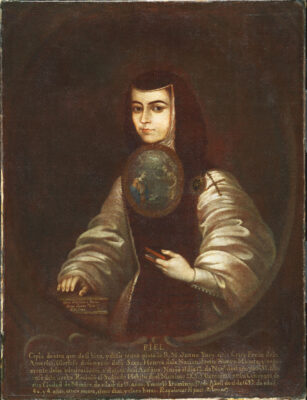
“But who has prohibited women private and individual studies? Do they not have a rational soul like men? … What divine revelation, what determination of the Church, what dictate of reason made for us such a severe law?” —Sor Juana Inés de la Cruz, in Autodefensa Espiritual (translated from Tapia Mendez 1993).
Born at the end of the Spanish “Golden Century,” Sor Juana Inés de la Cruz is, in many senses, the perfect embodiment of the Baroque spirit. Both her life and her writings are marked by a series of tensions and contrasts. Although it may have been possible for Sor Juana’s choices and life circumstances to destine her for a life of opprobrium and relative obscurity, given her birth out of wedlock, her oppressive and hierarchical colonial context, and her membership in a religious order, she ultimately became one of the most famous polymaths of the 17th century. For most of her life, she maintained close friendships with many members of the political and cultural elite of New Spain, and she achieved a series of literary and intellectual feats that led one of her admirers to describe her as “Madre que haces chiquitos a los más grandes” (“a Mother who makes the greatest so small”). Just as her personal and social life was marked by tensions between her marginal status as a nun and the central role she played in the cultural and intellectual life of New Spain under the patronage of two successive Vicereines, her writings are often marked by tensions and contrasts between competing aspirations. Indeed, while Sor Juana defends in some pieces her right to study and be educated, she demurs in others from certain intellectual pursuits, writing “También es vicio el saber” (“Knowledge is also a vice”). Praised and celebrated by many as “the Phoenix of Mexico” during her lifetime, she was nonetheless forced to recant her works at the end of her life.
In spite of all these tensions and contrasts, Sor Juana’s life and writings have continuously fascinated many people, both in her homeland and beyond. Her poetry and her plays have been the object of dozens of scholarly studies and monographs, all of which recognize her immense literary talent and her amazing poetic abilities. However, one aspect of Sor Juana’s polymathy that has received comparatively little attention is her engagement with philosophical questions. Though her philosophical work is not presented in conventional forms such as treatises or dialogues, some of her poetry (in particular, the epistemological poem First Dream, which is considered her masterpiece) and her letters (the Letter Worthy of Athena and the Reply to Sor Filotea) offer novel suggestions regarding the relationship between dreams and knowledge, the connection between the natural and the divine, and original arguments supporting the right of women to study and be educated. In addition to these intellectual accomplishments, Sor Juana displayed an interest in the indigenous groups of New Spain by composing a few pieces in Nahuatl and by offering a limited defense of indigenous cultures and religions in her Loa (prologue) to Divine Narcissus. She presented her thoughts on the duties of heads of state to their subjects in Allegorical Neptune, just as Bartolomé de las Casas had a century before her. In light of all this, Sor Juana stands not only as the first woman to have written substantial philosophical works on the American continent, but also as one of the first female indigenistas, thus paving the way for later figures such as noted Mexican novelist and essayist Rosario Castellanos.
| Preferred citation and a full list of contributors to this entry can be found on the Citation & Credits page. |
1. Biography
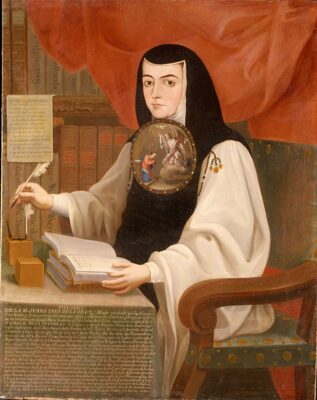
Juana Inés de Asbaje y Ramírez de Santillana was born on November 12 in either the year 1648 or 1651. In her early life, she also went by the shorter name Juana Ramírez de Asbaje. She adopted the more famous version of her name—Sor Juana Inés de la Cruz—after joining the Hieronymite order of nuns. She was born out of wedlock in the village of San Miguel Nepantla, 60 km southeast of Mexico City. She was the illegitimate child of Isabel Ramírez Santillana, a criolla woman (a person of white European Spanish descent born in the Americas), and Pedro Manuel de Asbaje y Vargas Machuca, a Spanish captain who left her life very early on, and about whom she knew very little. Understanding the societal role imposed upon her as a criolla and an illegitimate daughter—both of which were conditions that would have left others with no prospects in life—make her subsequent renown in court, intellectual history, and popular culture even more remarkable.
Although not much is known about her early life, it is clear that her maternal grandfather, Don Pedro Ramírez de Santillana, was an influential figure in her intellectual development. His extensive library captivated the precocious child prodigy, who later in life would say that at three years old, she was “inflamed with a desire to know how to read,” a skill which she soon accomplished. Her appetite for knowledge must have quickly shown her the benefits of a university education. During her lifetime, only males were allowed that privilege, however, and graduation from a university was a prerequisite for becoming a respected teacher. She begged her mother to dress her up in boys’ clothes so that she could attend such an institution in Mexico. “I began to plague my mother with insistent and importunate pleas: she should dress me in boy’s clothing and send me to Mexico City to live with relatives, to study and be tutored at the University” (Reply to Sor Filotea). Needless to say, she was scolded and never achieved this goal.
Sor Juana was apparently distressed by her lack of formal education. She complained about the unfortunate conditions of her early auto-didacticism in her later writings, “Study and more study, with no teachers but my books. Thus I learned how difficult it is to study those soulless letters, lacking a human voice or the explication of a teacher.” She added, “I undertook this great task without benefit of teacher, or fellow students with whom to confer and discuss, having for a master no other than a mute book, and for a colleague, an insentient inkwell” (Reply to Sor Filotea).
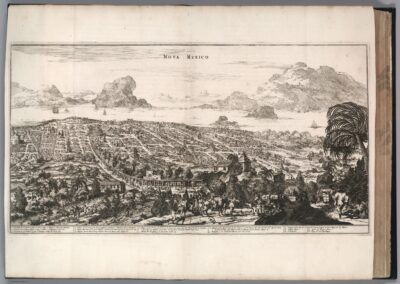
In 1656, she was sent to Mexico City by her mother to live with her maternal aunt and uncle, María Ramírez Santillana and Juan de Mata. Mexico City had around 50,000 inhabitants at the time and was the bustling heart of New Spain’s colonial life. She began her study of Latin in 1659 under the tutelage of Bachelor Martín de Olivas—it is said that she learned the language in only twenty lessons. If this is true, it is an early manifestation of the literary and linguistic genius that she demonstrated in her later work. In order to give herself motivation to study seriously, she would punish her own laziness or ineptitude by cutting her hair.
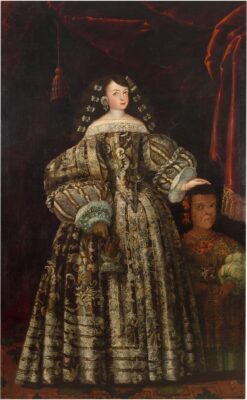
In 1664, she entered the court of Antonio Sebastián Álvarez de Toledo, 2nd Marquess of Mancera, as a lady-in-waiting for his wife, the Vicereine Leonor Carreto. The Viceroyals of New Spain were described as the “living images” of the monarchs in Spain, and therefore had some autonomy in the colonial government structure of the Viceroyal system, which stood in for imperial bureaucracy. They expressed love and loyalty for the monarch, and cooperated with them on important matters, so a position in the court of Leonor Carreto as a lady-in-waiting was an exceedingly impressive accomplishment for Juana Inés. The court was based on a household model, with blurred distinctions between the household and the bureaucratic figures. The patron and client relationships in this model were based on ties of loyalty and social networks, so Juana Inés benefitted from the prestige of being in the Vicereine’s household, especially since she managed to entertain the court with her witty command of language, poetry, and works of theatre.
She made her first attempt at religious life in August 1667, when she entered the Convent of San José de las Carmelitas de México. However, she renounced the Carmelites on November 18 of that year, largely due to their rigidity.
Upon returning to court, she underwent an examination by 40 scholarly men from the University of Mexico including philosophers, theologians, mathematicians, historians, poets, and humanists. This examination was arranged by the Viceroy to assess her intellect, after she had impressed the Viceroyal court; ultimately the men were astounded by her multi-disciplinary knowledge.
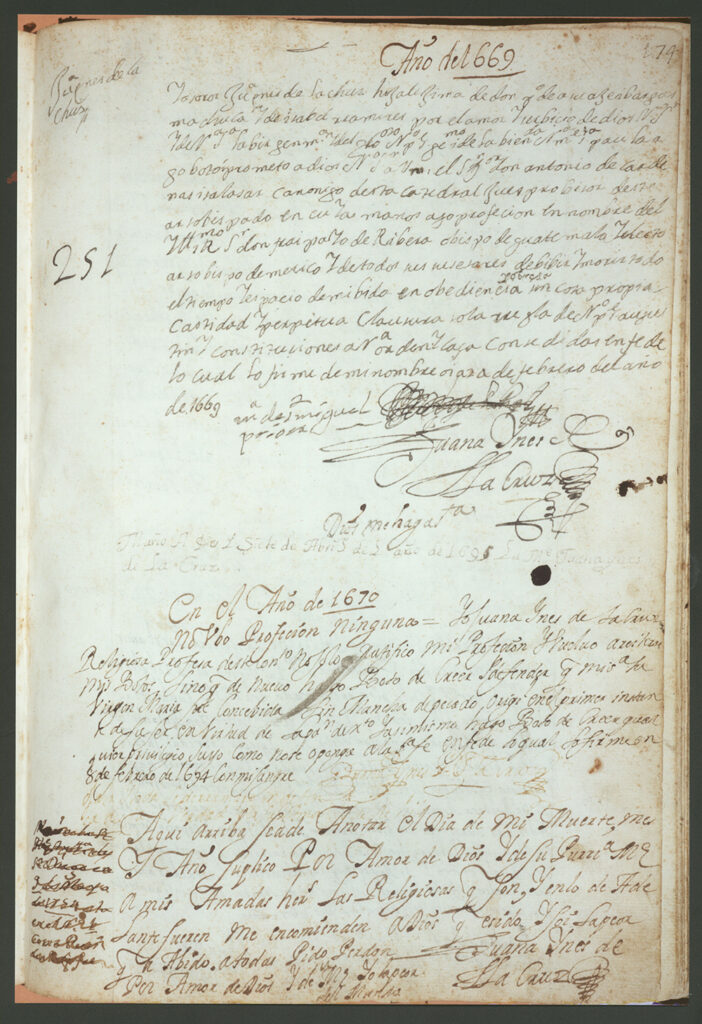
With no desire to marry, but rather searching for the autonomy necessary to study, she once again entered religious life, this time at the Convent of San Jerónimo in February 15, 1669. Here she would stay for the rest of her life, composing her life’s work in poetry, drama, and prose. The convent was one of the only places for women to pursue intellectual activity during her time, though the environment was not perfectly conducive to that pursuit, as can be seen from a controversy marking the end of her life. In her La Respuesta, she explained her motivation as animated by antipathy for marriage, despite the knowledge that convent life was going to entail “conditions most repugnant to my nature.” At this point, she transitioned from one distinct period of her life to another, from courtly life to religious life. However, she did continue to keep close connections with the court. For example, she frequently had visits from court members and friends such as Don Carlos Sigüenza y Góngora in the locutorio (a kind of parlor) of the convent, where they engaged in intellectual discussions called tertulias. The subjects ranged from secular to religious.
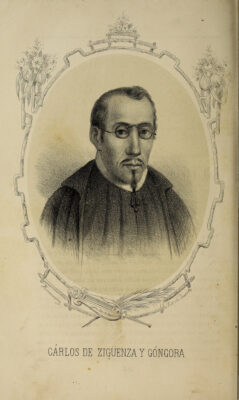
Her connection to court was further strengthened by her writing Allegorical Neptune, a long Baroque prose piece accompanied by explanatory poetic verses which was designed to decorate a triumphal arch in celebration of the incoming Viceroy of New Spain, Tomás de la Cerda y Aragón, Marquess of Laguna, and his wife María Luisa Manrique de Lara y Gonzaga. In it, she compares the virtues of the new Viceroy to those of the god Neptune, and establishes a link between ancient Egypt, Christianity, and New Spain. This work was so well-received that scholars consider this to have established Sor Juana’s long friendship with the new Viceroyals, who also became her patrons as the last ones had.
As detailed in her Letter from Monterrey, or Spiritual Self-Defense (Carta de Monterrey, or Autodefensa Espiritual) in 1681, this patronage also enabled her to eventually fire her confessor, Antonio Núñez de Miranda, who was jealous of her success and fame as his own declined.
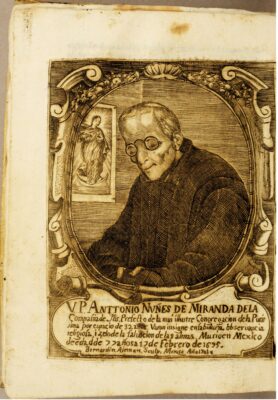
In addition to writing, she also worked as the accountant of the convent, and as a music teacher to the nearby girls’ school (by some accounts). There is a book of cooking recipes that was used by the convent, which may have been written by Sor Juana. She may also have written a small treatise on logic, and another on music theory, both of which are lost. In her personal nun’s cell, she was said to have a maid and 400–4000 volumes, along with scientific equipment such as a telescope, although portraits of her have tended to emphasize only her collection of literature. Some scholars describe her as the first bibliophile of the New World.
Throughout her life, she wrote over 200 works, often in groups of poems and villancicos, or carols, and in nearly all literary genres. Many were written for special occasions such as funerals, feasts, and birthdays. Two volumes of her poetry were published in Spain during her lifetime, and one shortly after. She also had a work entitled Castalidan Flood, of the Unique poet, the Tenth Muse of Mexico, Sor Juana Inés de la Cruz, published with the help of the Countess of Paredes.
In November 1690, a private letter from her to an acquaintance, later named Letter Worthy of Athena, or Critique of a Sermon, was published without her consent by the Bishop of Puebla. In her epistolary essay, she criticized a sermon given by Jesuit priest António Vieyra on Christ’s love. Vieyra claimed that the Church fathers St. John Chrysostom, St. Thomas Aquinas, and St. Augustine of Hippo did not understand the meaning of Christ’s demonstrations or proofs of his love, including the question of which among them was the greatest. Sor Juana takes up a defense of these three Church fathers and offers her own interpretation of the significance of Christ’s sacrifice and God’s demonstrations of love.
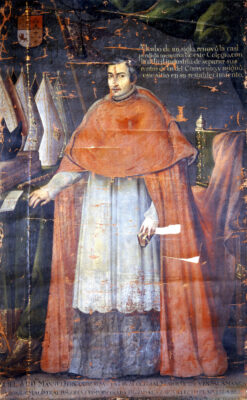
The Bishop of Puebla published the content of the letter along with his own response to her arguments under the pseudonym of Sor Filotea de la Cruz (i.e. Lover of God), impersonating a nun and chastising Sor Juana for not writing more on theology and for spending too much time on poetry and the profane sciences. The letter was respectful but threatening, insofar as it indirectly attacked her character and enjoined her to be more like other nuns of good repute. Although Sor Juana wrote a lengthy and substantial response to this attack, she did not publish it during her lifetime. The Response to the most Illustrious Poetess Sor Filotea de la Cruz was written on March 1, 1691, but published posthumously in 1700 in a volume titled Fame and Posthumous Works. In this magnificent epistolary essay, she mounted a defense of women’s right to study and teach. It is clear throughout this response that she believed religious devotion and intellectual freedom could go hand in hand, and that a woman need not forsake righteousness in order to study. The autobiographical details included in this essay have long attracted the fascination of scholars, and remain a central source for all biographies of Sor Juana’s life.
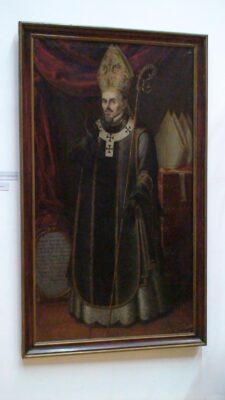
After the publication of these epistolary essays, Sor Juana turned towards more religious duties and withdrew from her public persona as an intellectual. Some scholars, including Irving Leonard and Octavio Paz, hold that powerful men in the church like Nuñez de Miranda and Aguiar y Seijas forced her to renounce her intellectual career and renew her vows as a “bride of Christ”. Indeed, there are documents showing her agreement to undergo penance for her previous work, including one which, in 1694, she famously signed “Yo, la Peor de Todas” (“I, the worst of all women”) in her own blood.
Sor Juana died on April 17, 1695 while treating a sick friend who was struck by a plague in the convent. Her body is supposedly buried in the Convent of Santa Paula of the “Hieronymite Order” of Saint Jerome. Although much of her work is lost to time, and her books and instruments were either given to charity or seized by officials, we cannot be certain that she stopped writing during the years leading up to her death.
An unfinished poem was found in Sor Juana’s cell after her death. It was addressed to her supporters in Spain, thanking them for “breathing another spirit into [her],” that is, giving her work new life by representing her not as she was — a nun struggling (as she put it) to “learn more [and] be ignorant about less” — but as they wanted to imagine her, a great intellectual, a sublime poet, a phoenix rising from the ashes.
1.1 Modern Reception
Sor Juana de la Cruz is one of those rare philosophical figures who not only left a tremendously influential and thought-provoking legacy for posterity, but also features prominently in the popular culture of an entire people. Her numerous “afterlives” have morphed with the sentiments of the times. While she took part enthusiastically in the intellectual conversations of her contemporaries, especially within the court of Viceregal New Spain and the circle of the Spanish literati, her ideas and name received little notice during the vast majority of the 18th and 19th centuries. However, her work has recently experienced a resurgence in the modern Mexican imagination, mainly due to her “re-discovery” by the renowned Mexican author Octavio Paz.

In 1982, Paz published a detailed biography on her work that skyrocketed her visibility both among scholars and the general public. In Sor Juana: Or, the Traps of Faith, he investigated what he saw as the great contradictions and mysteries of her life, including her ability to rise to fame from the unfortunate circumstances of her birth, her choice to go from glittering court erudite to cloistered nun, and her striking renunciation of books and secular learning. His contemporary esteem renewed interest in this symbolic figure, which has only grown in recent years. Prior to Paz’s seminal publication, the Complete Works of Sor Juana compiled by scholar Antonio Mendez Plancarte was the most notable work about her life and achievements. While Plancarte considered her philosophy and literature with a critical and academic perspective, Paz familiarized readers with the figure through his enthusiasm and engrossing writing.

Sor Juana first appeared on the obverse of the Mexican banknote in 1978, with the brown 1,000 peso. Therefore, her image was well known prior to Paz’s biography. Her revived popularity subsequent to the publication inspired her continued presence on Mexican banknotes. She was honored in 1985 on the 2,000 peso banknote and again in 2007 on the new 200 peso bill issued by the Banco de Mexico, along with an excerpt from one of her most famous poems:
“Foolish men, who accuse,
Women without reason,
Without seeing that you create,
The very faults that you identify.”
Clearly, she is celebrated primarily as a feminist icon—a figure who spoke out against the restrictions on female education and who criticized gender power dynamics in society.
Of all the figures hitherto published on Project Vox, Sor Juana has unquestionably had the greatest modern impact. There are diverse representations of Sor Juana in historical novels, poetry, plays, films, musical performances, and the visual arts. With countless books written by those both within and outside academic circles, her image has been reframed, reinterpreted, and sensationalized in countless ways, making research into her personage all the more complex and compelling. A film from 1990 called “I, the Worst of All”, based on Paz’s biography, has a distinctly sexual tone, rather than an intellectual one: “Lesbian passion seething behind convent walls… Engrossing, Enriching, and Elegant!” The title refers to the fact that she signed in blood a renunciation of her intellectual pursuits with the provocative statement, “I, the Worst of All”. Although the romanticization and sexualization of her image as a lesbian nun no doubt stems from her affectionate poems addressed to both the first and second Vicereines in her life, as perhaps most blatantly depicted in the theatre production “Los Favores de Sor Juana,” there is no strong evidence that she engaged in romantic pursuits with either of these women, let alone demonstrated such overt sexuality as a cloistered nun. As far as we can tell, she chose to forgo a life of sexuality for the freedom to study, which was offered to her by the cloister.
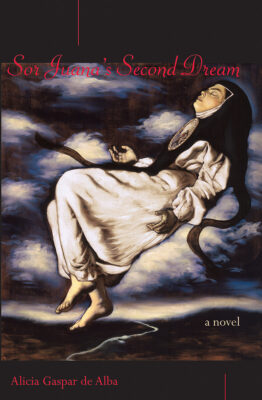
On the other hand, it is possible that our skewed modern reception aligns with her desire to be viewed as more fantastical than she truly was. She elaborates on this sentiment in an unfinished poem that was found in her cell after her death in 1695—this piece also proves that she never truly gave up writing after her renunciation, and continued her intellectual work in private. The poem was addressed to her supporters in Spain, whom she thanked for “breathing another spirit into [her].” In other words, she expressed gratitude to those fans who crafted a new, more exciting life around her image, representing her name as something other than how she saw herself in reality: a nun struggling to “learn more [and] be ignorant about less.” They apparently raised her to an ideal of intellectual prowess, sublime poetic skill, and the mythological Phoenix of Mexico. Some striking words from this unfinished poem are, “You imagine me, and I exist.”
This self-refashioning reflects our modern representation of her in many ways, given her evidential command of languages and of important philosophical concepts. Nevertheless, there is no explicit mention by Sor Juana about the lesbian fantasies that have been attributed to her in our popular culture. Consequently, the situation remains unclear, as Paz himself mentions. Queer readings of Sor Juana’s love poetry to the Vicereines are plausible, though without more information it is difficult to gain clarity on the matter.
However, as societal values have become more inclusive, her pleas for educational rights—though admirable and historically influential—do not provide the shock value that they would have had in the 17th century. It is perhaps for this reason that our contemporary lens morphs her image to maintain that sense of fascination in this new age. Of course, there is no need to stretch the truth when telling her story as the sheer intensity of all her work and the conditions of her life—as an illegitimate daughter in a sexually oppressive and intellectually stifling time—which complicated her rise to fame as a contrarian provide us with more than enough material for fascination.
Her image has also been the focus of more interest in the Western world in recent years, especially due to her identity, which straddled religious orthodoxy and intellectual freedom, and her prescient efforts in multiculturalism are now constantly in our minds. She melded colonial and indigenous languages in her poetry, giving an unprecedented voice to Native American symbols and religious traditions in the Viceroyal court while stressing her own criolla identity.
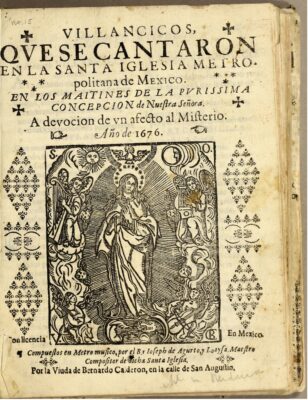
For example, parts of Sor Juana’s “Villancico 224” were written in Nahuatl, while others were in Spanish. Switching between the two languages, she centered her narrative on both the Catholic Virgin of Guadalupe and Cihuacoatl, an indigenous goddess. We can see that she was not afraid to break boundaries between cultures, engaging in comparative religious explorations that equated the worth of Native American religions to that of Catholic saints—a striking decision given her life-long role as a Catholic nun during the time of the Inquisition. The dual focus of her work is such that it is often ambiguous whether she prioritized Catholic or indigenous religious figures, or whether she sought to harmonize the two. Scholars such as Nicole Gomez argue that her fusion of Spanish and Aztec religious traditions aimed to raise the status of indigenous religious traditions to equal that of Catholicism in New Spain as well as to chastise the egregious violence against native communities and traditions by New Spain.
Another example of her intercultural interests is seen in her Loa, or Prologue, to the Divine Narcissus. She centered this play on the interactions between two pairs of aptly named peoples from Indigenous and Spanish cultures, Occident and America, and Religion and Zeal, respectively. The work is informative in its description of Aztec rituals and gods, including Huitzilopochtli, who symbolized the land of Mexico. In their encounters, the two pairs of opposing peoples discuss their religious perspectives and come to the conclusion that their similarities are greater than their differences. Surely this was a noble attempt at religious harmony during the tumultuous and aggressive period of her life. In our contemporary age of religious extremism and hostility, we can undoubtedly admire and learn from her efforts to foster conversation between people of different backgrounds and bridge cultural divides by emphasizing similarities.
In Mexico, she is viewed as a more political figure in the sense that she is claimed by the nation as a visionary philosopher who belongs wholly to Mexico, unlike the typical thinkers who hailed from Spain during the Spanish Golden Age. Consequently, she has become a strong symbol of Mexican national pride, and has been promoted as such by the government.
Sor Juana’s name was inscribed in gold on the wall of honor in the Mexican Congress in April 1995. The town where Sor Juana grew up, San Miguel Nepantla in the municipality of Tepetlixpa, State of Mexico, was renamed in her honor as Nepantla de Sor Juana Inés de la Cruz, and the walls of the town are adorned with her image. She is also known in the whole of Latin America as the “Tenth Muse” and the “first feminist of the Americas,” as well as the “Phoenix of Mexico.”
There are also connections drawn between Sor Juana and the more modern and popular artist Frida Kahlo. Scholar Theresa A. Yugar has focused her research with the question, “Why does the world know more about Frida Kahlo than Sor Juana Inés de la Cruz?” This comparison has since gained traction, and the University of the Cloister of Sor Juana honored both Frida Kahlo and Sor Juana on October 31, 2018 with a symbolic altar.
Sor Juana’s numerous complexities involving gender roles, racial identity, and religious harmony make her an especially modern thinker who fits well into the multicultural discourse of our day, and her influential life during the Golden Age makes her a proto-feminist from the New World. Therefore, if we want to understand more about our own age of ambiguity, globalization, and crossing boundaries, it would be beneficial to examine her novel approach to these issues, which, before most other people, she recognized as significant concerns for our collective humanity.
1.2 Chronology
| Date | Event |
| 12 November 1648 (or 1651) | Sor Juana is born as Juana Inés de Asbaje y Ramírez de Santillana in the village San Miguel Nepantla, though the exact date is still debated. In her early life also went by Juana Ramírez de Asbaje. Only in 1669, once she entered the convent, did she take her more well-known name: Sor Juana Inés de la Cruz. |
| 1656 | Sor Juana is sent to Mexico City to live with her maternal aunt and uncle: María Ramírez Santillana and Juan de Mata. |
| 1659 | Sor Juana begins studying Latin under the tutelage of Bachelor Martín de Olivas. She allegedly picked up the language in 20 lessons. |
| 1664 | Sor Juana joins the court of the Marquis and Marquise of Mancera in Mexico City. These Viceroyals were considered to be like “living images” of the monarch in Spain. |
| 1667 | Sor Juana enters the Convent of San José de las Carmelitas de México in August. On November 18 of the same year, she renounces her place for the convent’s rigid practices and style of worship. She then returns to the Viceroyals‘ court. |
| 1668 | The Marquis of Mancera gathers 40 male courtiers comprised of philosophers, theologians, mathematicians, historians, poets and other humanists to examine her intellect. She passes the thorough questioning and gains a prodigious reputation. |
| 1669 | Sor Juana enters the Convent of San Jerónimo in Mexico City on February 15 and remains there until her death. In committing to the convent, she severed ties with her official position at the Viceroyals’ court, though she retained a close and unofficial relationship with the remaining courtiers (i.e. Carlos Sigüenza y Góngora). |
| 1689 | Sor Juana composes two conjoined plays: the Divine Narcissus (Divino Narciso) and its Loa, or prologue. |
| 1690 | The Bishop of Puebla, Manuel Fernández de Santa Cruz, publishes Sor Juana’s critique of a sermon by Jesuit priest António Vieyra, and does so without her consent. The published critique is named Letter Worthy of Athena (Carta Atenagórica). |
| 1691 | Sor Juana replies to the Bishop of Puebla with her Reply to Sor Filotea (Respuesta a sor Filotea de la Cruz). |
| 1692 | Sor Juana composes her poem First Dream (Primero Sueño). |
| 1694 | Antonio Nuñes de Miranda and Don Francisco de Aguiar y Seijas, religious leaders in Mexico City, lead a secret case against Sor Juana and sentence her to a renunciation of her intellectual career. The written renunciation is signed in her blood. |
| 1695 | Sor Juana dies on 15 April 1695. Her body is supposedly buried at the Convent of Santa Paula, of the Order of San Jerónimo. |
2. Primary Sources Guide
The publication of Sor Juana’s works was undertaken in two main periods. In the first, which roughly encompassed the last two decades of the 17th century, a selection of Sor Juana’s works was published in Spain. The first volume, which was published in Madrid by Juan García Infanzón under the title Inundación Castálida de la única poetisa (1689), included various sonnets, romances, décimas, loas, and the various poems and other texts that comprised the Neptuno Alegórico. This selection of works proved extremely popular in Spain. The Inundación Castálida was promptly followed by another volume titled Segundo tomo de las obras de sóror Juana Inés de la Cruz (1692), which was published in Seville by Tomás López de Haro. This volume contained various other poems previously unpublished (in particular sonnets, romances, endechas, and villancicos) as well as Primero Sueño, the Carta Atenegórica, and her two secular plays Los Empeños de una Casa and Amor es más laberinto.
Subsequently, a few years after the death of Sor Juana, a third volume entitled Fama y obras póstumas del fénix de México (1700) was published in Madrid by Manuel Ruiz de Murga. This volume contains a series of poems that were written by various figures to honor and commemorate Sor Juana, as well as several pieces authored by Sor Juana that were not included in the two previously mentioned volumes. This volume contained the religious or devotional exercises as well as a series of other poems that had not been published previously, including the romance dedicated to her by the Count of La Granja and the romance that she penned in response. Fama y obras póstumas also features an elaborate frontispiece, engraved by Clemens Puche after a drawing by Joseph Caldevilla, that reflects the volume’s commemorative message. Composed of rich visual and textual symbolism, this frontispiece highlights Sor Juana as a cultural mediator between Spain and the New World.
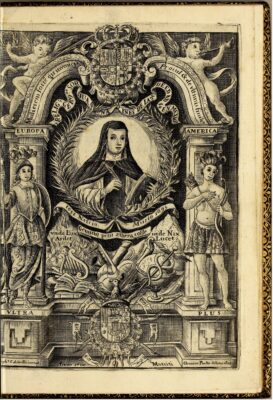
At the center, we find a bust portrait of Sor Juana wearing the white tunic with a dark outer layer that was typically worn by Hieronymite nuns. Another reference to Saint Jerome is the banner above her that reads: “Mulierem fortē qis inveniet? / Procul & (et) de ultimis finibus?” This translates roughly to: “Who can find a strong or virtuous woman? / For her price [is] far above jewels.” It comes from the Vulgate, a version of the Bible translated into more everyday “vulgar” Latin by Saint Jerome in the late fourth century that became the standard version of the Old Testament used by the Catholic Church.
In her hands, Sor Juana holds a book and quill whose tip hovers as if we have just interrupted her writing something down. These attributes represent her legacy as a prominent scholar in Mexico. Indeed, Sor Juana was often referred to as the “Tenth Muse” by peers and admirers during her lifetime (Boyle 2016). The frontispiece visualizes her esteemed intellectual status in the form of an angel at the top right who plays a bugle or small trumpet, a common symbol of victory, triumph, and glory. Read as a fanfare trumpet and associated with military fanfare, this trumpet implies the fame and far-reaching impact of Sor Juana’s writings.
Below Sor Juana are multiple objects that further allude to her capacious humanist knowledge: the Staff of Hermes, a violin, a lute, a globe, and various books. The Staff of Hermes, also known as a caduceus, is a reference to ancient Greek mythology. Hermes was messenger of the gods, as well as the god of travel, trade, and diplomacy. The caduceus in Sor Juana’s frontispiece could signal her relation to diplomacy and imperialism of the Spanish Empire. Including this ancient Greek symbol of travel and trade links Sor Juana to Europe and nods to her classical intellectual heritage. The globe likewise symbolizes travel and reinforces the frontispiece’s theme of colonial expansion and exchange.
To either side of Sor Juana are two soldiers that represent conventional allegories of Europe and America. The soldier symbolizing “Europa” on the left is formally dressed in military gear and gladiator sandals. He holds a spear and shield to convey Europe as a civilized continent with advancements in armor and weaponry. His proud stance, looking up and slightly puffing out his chest, further signals European conquest. The soldier on the right, labelled “America,” represents a stereotypical image of the New World, appearing in a skirt with his torso and feet bare. His weaponry, a bow and arrows, suggest the perceived technological inferiority of native Mexican peoples at the time. Compared to Europe, he is posed more demurely, with a downward gaze and hand to his chest in a gesture reminiscent of the classical Venus pudica.
Other details, however, lessen the sartorial and behavioral opposition of the two soldiers. For example, both figures are rendered with the same skin tone and facial features. This is unusual for early modern Western depictions of race. As in painted or sculpted allegorical series of the four continents, for example, European artists tended to misrepresent physiognomic and cultural differences between European and New World peoples to the point of caricature.
It is possible that Caldevilla was familiar with Sor Juana’s work and had her previous writings in mind when he designed the frontispiece to Fama y obras póstumas. In Loa, the prologue play to her Divine Narcissus, Sor Juana portrays allegorical characters named America and Occident, as native to the Americas, and European characters named Zeal and Religion (see Section 4.8 below). One can imagine that in a performance of Loa, these characters would have been costumed like the stereotypical allegories on her posthumous frontispiece. As the narrative of Loa progresses, these characters transition from a combative to a more constructive dialogue about native and Christian belief systems.
Similarly, by positioning Sor Juana between the two soldiers, the 1700 frontispiece signals her interest in merging of European and indigenous American customs. It communicates her religious ties to Spain, as a member of Saint Jerome’s Order, and her life in Mexico City. This placement alludes to her bridging of different worlds: Sor Juana used her teachings with European religious and academic roots to help form an intellectual community in the Spanish viceroyalty. In 1700, her Fama y obras póstumas del fénix de México was published in Madrid with the help of Juan Ignacio de Castorena y Ursúa. This publication spread awareness of New World literary achievements like Sor Juana’s and fostered intellectual networks with Spain (Robles 2021, p. 62-63).
Finally, underneath Sor Juana is a banner that reads: “Unde Lix [Lux] Ardet,” “Gemino petit aethera colle,” “Inde Nix Lucet.” This loosely translates to: “Whence light burns,” “The twin peaks [of Parnassus] soar to heaven,” “The snow shall shine” (The Princeton University Dante Project 2011, https://dante.princeton.edu/cgi-bin/dante/DispCommentByTitOrId.pl?EDIT=1&INP_ID=249786). This is an excerpt from the epic poem Pharsalia written by the Roman poet Lucan in the 1st century C.E. The line is a reference to Mount Parnassus in central Greece. Between the twin peaks of Parnassus was Delphi, considered the center of the classical world and the home of the nine Muses. The phrase in Sor Juana’s frontispiece could nod to her position between the “two peaks” of the Old and New Worlds. It also implies that she occupies Delphi, a fitting residence for the “Tenth Muse.”
After this first main period around 1700, Sor Juana’s works experienced a profound revival of interest during the 20th century. This interest led Mexican literary scholars such as Manuel Toussaint and Emilio Abreu Gómez to publish some brief selections of her poems in the 1920s and 1930s. A more substantial selection of her works was edited by Antonio Castro Leal, which includes her theater and prose works. This edition was published by Editorial Porrúa in 1948 and was republished numerous times.
The most authoritative edition of her complete works was edited and published by the Catholic priest and literary scholar Alfonso Méndez Plancarte (1909–1955), who introduced, edited and annotated the first three volumes published by the Fondo de Cultura Económica (FCE) in Mexico City (1951–52, 1955). The first volume includes Sor Juana’s lyrical poetry, the second her villancicos and other religious poetry, and the third her religious plays (the autos and loas). Méndez Plancarte was unable to complete his editorial work on the last volume due to an untimely death. The fourth and last volume of Sor Juana’s Obras Completas was published in 1959 under the direction of Alberto Salceda, and contains her secular plays, the Neptuno Alegórico, and her prose pieces. The first volume of this collection was recently re-edited in 2009 under the direction of Antonio Alatorre, who addressed some of its lacunae. To this day, the Méndez Plancarte and Salceda edition of Sor Juana’s complete works (along with the re-edited first volume prepared by Antonio Alatorre) remains the best scholarly edition of Sor Juana’s complete works.
There is another edition of her complete works which has been introduced by Francisco Monterde. This edition, originally published by Editorial Porrúa in Mexico City in 1969, has undergone multiple reprints. Subsequent partial editions of her works typically follow the texts established by Méndez Plancarte and Salceda, though there are facsimile editions of the original publications of Inundación Castálida, Segundo Volumen, and Fama y Obras Póstumas that were reprinted by the National Autonomous University of Mexico (UNAM) in 1995.
2.1 Major Works
Cruz, Sor Juana Inés de la. 1689. Inundación castálida de la única poetisa. Madrid: Juan García Infanzón.
—. 1692. Segundo tomo de las obras de sóror Juana Inés de la Cruz. Sevilla: Tomás López de Haro.
—. 1700. Fama y obras póstumas del fénix de México. Madrid: Manuel Ruiz de Murga.
2.2 Critical Editions
Cruz, Sor Juana Inés de la. 1916. Poesías escogidas, edited by Manuel Toussaint. México: Imprenta Victoria.
—. 1928. Obras escogidas, edited by Manuel Toussaint. México: editorial Cvltvra.
—. 1928. Primero sueño, edited by Ermilo Abreu Gómez, Contemporáneos (México) I, 272–313, II, 46–54.
—. 1941–1948. Poesías completas, ed. popular revisada por Ermilo Abreu Gómez. México: Botas.
—. 1940. Poesías escogidas, edited by Francisca Chica Salas. Buenos Aires: Estrada.
—. 1940. Poesías (selectas), edited by Ermilo Abreu Gómez. México: Botas.
—. 1944–1988. Poesía, teatro y prosa, edited by Antonio Castro Leal. México: Porrúa.
—. 1951. Obras Completas, tomo I, edición y notas de Alfonso Méndez Plancarte. México: Fondo de Cultura Económica.
—. 1952. Obras Completas, tomo II, edición y notas de Alfonso Méndez Plancarte. México: Fondo de Cultura Económica.
—. 1955. Obras Completas, tomo III, edición y notas de Alfonso Méndez Plancarte. México: Fondo de Cultura Económica.
—. 1957. Obras Completas, tomo IV, edición de Alberto G. Salceda. México: Fondo de Cultura Económica.
—. 1953. Primero sueño, ed. de la Sección de Literatura Iberoamericana de la Universidad de Buenos Aires, con la colaboración de Juan Carlos Merlo, nota preliminar de Gerardo Moldenhauer. Buenos Aires: Imprenta de la Universidad.
—. 1968. Obras escogidas, edited by Juan Carlos Merlo. Barcelona: Bruguera.
—. 1976. Obras selectas, edited by Georgina Sabat de Rivers y Elias L. Rivers. Barcelona: Clásicos Noguer.
—. 1979. Respuesta a Sor Filotea, edited by Grupo Feminista de Cultura. Barcelona: Laertes.
—. 1979. Florilegio, edited by Elías Trabulse. México: Promexa.
—. 1982. Inundación castálida, edited by Georgina Sabat de Rivers. Madrid: Castalia.
—. 1986. Carta de Sor Juana Inés de la Cruz a su confesor: autodefensa espiritual, edited by Aureliano Tapia Méndez. Monterrey: Impresora Monterrey; Reimpreso (1993). Monterrey: Producciones Al Voleo / El troquel.
—. (1987). «La carta de Sor Juana al P. Núñez (1682)», estudio de Antonio Alatorre en Nueva Revista de Filología Hispánica, t. XXXV, núm. 2. México: El Colegio de México, 591– 673.
—. (1989). El sueño, edited by Alfonso Méndez Plancarte. México: UNAM / Biblioteca del estudiante Universitario.
—. (1989). Fama y obras póstumas de Sor Juana Inés de la Cruz, edición facsimilar de la edición de 1714, Imprenta de Antonio González de Reyes, edited by Fredo Arias de la Canal. México: Frente de Afirmación Hispanista.
—. (1989). Obras completas, prológo y edición Francisco Monterde. México: Porrúa.
—. (1989). Los empeños de una casa, edición, estudio, bibliografía y notas Celsa Carmen García Valdés. Barcelona: PPU.
—. (1990). La segunda Celestina, edited by Guillermo Schmidhuber. México: Vuelta.
—. (1993). Invndacion Castalida de la vnica poetisa, mvsa décima Soror Jvana Ines de la Crvz, facsímile de la edición española de 1689. Introducción y reseña histórica por Aureliano Tapia Méndez, estudio, índice analítico y concordancia con las Obras completas por Tarsicio Herrera Zapién. Toluca: Instituto Mexiquense de Cultura.
—. (1994). Enigmas ofrecidos a la casa del placer, edited by Antonio Alatorre. México: El Colegio de México.
—. (1994). The Answer/La Respuesta, ed. crítica y trad. Electa Arenal y Amanda Powell. New York: The Feminist Press.
—. (1995). Carta Atenagórica, ed. facsimilar de la primera edición, 1690, Puebla de los Ángeles, imprenta de Diego Fernández de León, prólogo de Elías Trabulse. México: CONDUMEX.
—. (1995). Enigmas ofrecidos a la Casa del placer, edición y prólogo de Antonio Alatorre. México: El Colegio de México.
—. (1995). Fama y obras póstumas, edición facsimilar tomada de la edición de Madrid, 1700, introducción de Antonio Alatorre. México: Facultad de Filosofía y Letras, Universidad Nacional Autonóma de México.
—. (1995). Inundación castálida, ed. facsimilar tomada de la edición de Madrid, 1689, presentación de Sergio Fernández. México: UNAM.
—. (1995). Obra selecta, selección y prólogo de Margo Glantz, cronología y bibliografía de María Dolores Bravo, t. I y II. Caracas: Ayacucho.
—. (1995). Segundo volumen de las Obras de Sor Juana Inés de la Cruz y la Segunda Celestina, ed. facsimilar tomada de la edición de Sevilla, 1692, Prólogo de Margo Glantz. México: Facultad de Filosofía y Letras / UNAM.
—. (1998). Amor es más laberinto, prólogo de Margo Glantz, Buenos Aires, Impsat.
—. (2004). Obras completas de Sor Juana Inés de la Cruz en Cd-Rom, Rosario. Argentina: ediciones Nueva Héla. También se localiza en la Biblioteca editorial Libro electrónico.
—. (2014). El sueño, edición y prólogo de Roberto Echevarren. Montevideo: Colección La flauta mágica.
—. (2014). Nocturna, más no funesta. Poesía y cartas, edición, prólogo y notas de Facundo Ruiz. Buenos Aires: Corregidor.
—. (2016). Selected works, edited by Anna More and translated by Edith Grossman, New York: Norton.
3. Secondary Sources Guide
Arenal, Electa and Stacey Schlau. 1989. Untold Sisters: Hispanic Nuns in their own Works. Albuquerque: University of New Mexico Press.
Aspe Armelle, Virginia. 2018. Approaches to the Theory of Freedom in Sor Juana Inés de la Cruz. Queretaro: Aliosventos Ediciones.
Benítez, Laura. 1994. “Sor Juana Inés de la Cruz y la filosofía moderna.” In La literatura novohispana. Revisión crítica y propuestas metodológicas., edited by J. Pascual Buxó y A. Herrera. México, UNAM.
—. 2020. Sensibility and Understanding in Sor Juana Inés de la Cruz. In Feminist History of Philosophy: The Recovery and Evaluation of Women’s Philosophical Thought. Edited by Eileen O’Neill and Marcy Lascano. Cham: Springer, 75–98.
Bergmann, Emilie L. and Stacey Schlau. 2017. “Introduction: Making and Unmaking Myth in Sor Juana Studies.” In The Routledge Research Companion to the Works of Sor Juana Inés De La Cruz. Edited by Emilie L. Bergmann and Stacey Schlaw. New York: Routledge, Taylor & Francis Group, ix–xx
Beuapied, Aída. 1996. “El silencio hermético en Primero Sueño a la luz de la figura y las ideas de Giordano Bruno.” Hispania 79 (4): 752–61.
Beuchot, Mauricio. 1982. “Poesía y filosofía escolástica en Sor Juana.” Literatura Mexicana 3 (1): 269–81
—. 2001. Sor Juana. Una filosofía barroca (2nd ed.). Toluca: UAEM/CICSyH.
Boyle, Catherine. 2016. “Sor Juana Inés De La Cruz: The Tenth Muse and the Difficult Freedom to Be.” In A History of Mexican Literature, edited by Ignacio M. Sánchez Prado, Anna M. Nogar, José Ramón Ruisánchez Serra, 66-80. Cambridge: Cambridge University Press.
Buxó, Pascual. 1989. “Sor Juana Egipciana: Aspectos Neo-Platónicos de El Sueño.” Mester 18 (2): 1–17
Calvo, Hortensia and Beatriz Colombi. 2015. Cartas de Lysi. La mecenas de Sor Juana Inés de la Cruz en correspondencia inédita. Madrid, Frankfurt, México: Iberoamericana, Vervuert, Bonilla
Cañeque, Alejandro. May 3, 2017. “The Empire and Mexico City.” In The Routledge Research Companion to the Works of Sor Juana Inés de la Cruz. Routledge. Accessed on March 26, 2020.
De la Peña, Ernesto. “Villancicos de Sor Juana.” Programa Música para Dios. Uploaded YouTube 2018, Accessed on January 6, 2021. URL: https://www.youtube.com/watch?v=rX1Z2itNKYc.
Embassy of Mexico in India. “The First Feminist of the New World: Sor Juana.” Medium. Published March 8, 2018. URL: https://medium.com/@embamexindia/the-first-feminist-of-the-new-world-sor-juana-5ea22b35ca9.
Juana, I. C., Garrido, G., Flores, A., Tardio, G. B., Durán, M. A., Araujo, J., Mesa, Cor Vivaldi. 1999. Le phénix du Mexique: Villancicos de Sor Juana Inès de la Cruz. France: K617.
Gaos, José. 1960. “El sueño de un sueño.” Historia Mexicana, 10 (1): 54–71.
Glantz, Margo. 1996. Sor Juana Inés de la Cruz: saberes y placeres. Toluca: Estado de México: Gobierno del Estado de México, Instituto Mexiquense de Cultura.
Gonzalez Díaz, Marta. 2012. “Reflexiones sobre Primero Sueño de Sor Juana Inés de la Cruz.” Lingüística y Literatura 61: 343–55.
Grossi, Verónica. 2007. Sigilosos v(u)elos epistemológicos en Sor Juana Inés de la Cruz. Madrid: Iberoamericana; Frankfurt am Main: Vervuert.
Kennet, Frances. 2000. “The Theology of The Divine Narcissus.” Feminist Theology 9 (25): 56–73.
Kirk, Stephanie. 2017. “The Gendering of Knowledge in New Spain: Enclosure, Women’s Education, and Writing.” In The Routledge Research Companion to Sor Juana Inés de la Cruz. Edited by Emilie Bergmann and Stacey Schlau.
—. 2016. Sor Juana Inés de la Cruz and the Gender Politics of Knowledge in Colonial Mexico. Abingdon, Oxon; New York, NY: Routledge.
López Cámara, Francisco. 1957. “La conciencia criolla en Sor Juana y Sigüenza.” Historiografía Mexicana 6 (3): 350–73.
Moreno, Rafael. 1980. “La filosofía moderna en la Nueva España.” In Estudios de historia de la filosofía en México, (3rd ed.). México: UNAM, 123–32.
Noddings, Nel. 1984. Caring: A Feminine Approach to Ethics and Moral Education. Berkeley, CA: University of California Press.
Olivares Zorrilla, Rocío. 2014. “Sor Juana y Nicolás de Cusa.” Hipogrifo 2 (2): 107–25.
Paz, Octavio. 1990. Sor Juana. Cambridge, MA: Belknap Press.
—. 1987. Sor Juana, o, Las trampas de la fe. Mexico: Fondo de Cultura Económica.
Peden, Margaret Sayers. 1982. A Woman of Genius: The Intellectual Autobiography of Sor Juana Inés De La Cruz. Salisbury, CT: Lime Rock Press.
Poot Herrera, Sara. 1998a. “Las cartas de Sor Juana: públicas y privadas.” In Sor Juana Inés de la Cruz y sus contemporáneos, edited by Margo Glantz. Universidad Nacional Autónoma de México y Centro de Estudios de Historia de México Condumex, 291–317.
—. 1998b. “Una carta finamente calculada: la de Serafina de Cristo.” In Sor Juana & Vieira, trescientos años después, Anejo de la revista Tinta, edited by K. Josu Bijuesca y Pablo A. J. Brescia. Santa Barbara, CA: University of Santa Barbara, 127–41.
Robles, José Francisco. 2021. Polemics, Literature, and Knowledge in Eighteenth-Century Mexico: A New World for the Republic of Letters. Oxford University Studies in the Enlightenment. Liverpool: Liverpool University Press.
Rodríguez Garrido, José Antonio. 2006. La Carta Atenagórica de Sor Juana. Textos inéditos de una polémica. Mexico City: UNAM.
Sabat-Rivers, Georgina. 1976. “Sor Juana y su Sueño: antecedentes científicos en la poesía española del Siglo de Oro.” Cuadernos Hispanoamericanos 310: 186–204.
—. 1992. “Sor Juana: imágenes femeninas de su científico Sueño.” In her Estudios de literatura hispanoamericana. Lecturas Hispánicas y Universales, no. 6. Barcelona: Promociones y Publicaciones Universitarias, 305–326.
Soriano Valles, Alejandro. 2000. El Primero Sueño de Sor Juana Inés de la Cruz: bases tomistas. Mexico City: UNAM/Instituto de Investigaciones Estéticas.
Stavans, Ilan. 2018. Sor Juana or, the Persistence of Pop. Tuscon: University of Arizona Press.
Tenorio, Marta Lilia. 1999. Los Villancicos de Sor Juana. Mexico City: El Colegio de México.
—. 2019. «Góngora y sor Juana: una vez más» Cátedra Góngora. YouTube Recording, Accessed June 2020, URL: https://www.youtube.com/watch?v=C0t8YgdaZ3I.
“The Princeton Dante Project (2.0) – Commentary Par I 16-18.” Princeton University. The Trustees of Princeton University. Accessed November 22, 2021. URL: https://dante.princeton.edu/cgi-bin/dante/DispCommentByTitOrId.pl?EDIT=1&INP_ID=249786
Trabulse, Elías. 1982. El círculo roto: estudios históricos sobre la ciencia en México. México City: Fondo de Cultura Económica.
Vossler, Karl. 1953. “Introducción.” In Primero Sueño. Buenos Aires: University of Buenos Aires Press.
Xirau, Ramón. 1970. Genio y figura de Sor Juana Inés de la Cruz (2nd ed.). Buenos Aires: University of Buenos Aires Press.
Wirzba, Norman. 2003. Neither Saints nor Sinners: Writing the Lives of Women in Spanish America. New York: Oxford University Press USA.
4. Philosophy & Teaching
Before reviewing Sor Juana’s works for their philosophical contributions, it is important to briefly consider some of the main philosophical influences that played a role in the articulation of her views. Since Sor Juana was extremely well read—in fact, it is likely that her personal library was, at some point, the most extensive one on the American continent—her writings are filled with references to classical and medieval figures, as well as references to authors from her own time period. Unfortunately, her library was dispersed after her death, so we cannot conclusively establish which books it contained. Various scholars have, however, been able to identify some of her influences. For instance, scholars such as Karl Vossler (1953), Elías Trabulse (1982), José Pascual Buxó (1989), and Aída Beaupied (1996) have noticed and studied the influence of Hermetic and Neo-Platonic authors in her work, stressing existing parallels between recurring themes in Sor Juana’s writings and themes articulated in the Hermetic Corpus as well as in figures such as Giordano Bruno and Athanasius Kircher. Scholars such as Mauricio Beuchot (1992, 2001) and Alejandro Soriano Vallés (2000) have detailed the influence of Thomas Aquinas on her writings. Virginia Aspe Armella (2018) has stressed the impact of Spanish Scholastic figures, primarily Jesuits such as Francisco Suárez and Luis de Molina, on Sor Juana’s writings. Finally, Laura Benítez (1994, 2020) has emphasized that many of Sor Juana’s writings exhibit a strong critical attitude, always initially directed at herself, that bears strong resemblance to the attitudes displayed by Bacon, Montaigne, and Descartes, while others such as José Gaos (1960), Ramón Xirau (1970) and Rafael Moreno (1995) outline her apparent Cartesian methodological modernism. Scholars in sister disciplines have outlined the vast array of her poetic and literary influences, particularly her roots in the Spanish Baroque, and some scholars have begun to inquire into her potential influences from pre-Columbian sources.
Sor Juana’s philosophical contributions are generally not presented in a systematic and unified fashion within single monographs. Instead, they are distributed among the many writings she penned throughout her life, which span multiple genres including prose, many forms of verse, allegorical and narrative drama, correspondence, and spiritual exercises. For the sake of offering a tentative, if incomplete, taxonomy of her thought, we proceed in the following fashion. We begin with a general overview of her two most important and well-known works, namely, First Dream and the Reply to Sor Filotea. We focus on offering a brief account of the content of each work, detailing the influences that shaped Sor Juana’s writing, presenting the main philosophical themes that emerge in each text, and highlighting some of the central philosophical questions that are raised and addressed by both pieces. Following this, we offer a brief treatment of Sor Juana’s Spiritual Self-Defense, which provides additional autobiographical context and furthers a conception of Sor Juana as a self-determining figure with feminist convictions, capable of standing up for herself and her own rights. After this general overview of her two major works and major epistolary essay, we present a number of other, lesser-known texts in which we find more of Sor Juana’s interesting contributions to philosophy. We first address her views on value theory, beginning by discussing her views on ethics and moral psychology as they appear in various works such as the philosophical-moral sonnets, her secular plays The Trials of a House and Love is a Labyrinth, and a selection of her work in verse.
After covering Sor Juana’s contributions to value theory, we offer an overview of her conception of a good ruler as presented in her unusual piece Allegorical Neptune, highlighting the character traits which she suggests a good prince should have, how these character traits can be cultivated, and what type of relationships a ruler should have with his or her subjects and with God. Subsequently, we discuss Sor Juana’s views on philosophical theology as they are articulated in the Critique of a Sermon, or Letter Worthy of Athena, focusing on her arguments regarding the significance of Christ’s sacrifice and why humans should love God, even if their love does not bring any benefit to God. We then discuss Sor Juana’s allegorical play Divine Narcissus and its Loa, or prologue. We suggest that Sor Juana articulates in the Loa a conception of the Indigenous groups of the American continent as rational beings that are susceptible to arguments to abandon idolatry and worship the true God, and begins to construct her own self-understanding. We then suggest that in the headlining play Divine Narcissus, Sor Juana toys with allegorical juxtapositions to offer alternative conceptions of the Eucharist, the Trinity, and the true requirements of piety. We then consider Sor Juana’s devotional exercises, which contain moral and theological reflections. Finally, we turn to examine a series of pieces in which Sor Juana discusses the nature of music and establishes important connections among poetry, food, and cooking in order to examine Sor Juana’s views on beauty and art.
Sor Juana’s Villancicos and Music
A vast number of Sor Juana’s surviving pieces are villancicos, which may be referred to as carols, and the entire second volume of her four volumes of collected works is dedicated to them. She composed them periodically at the request of important clergy-members and dignitaries throughout her writing career. The present analysis will but skim the depths of these brief but often overlooked parts of Sor Juana’s oeuvre, of which Martha Lilia Tenorio (1999) says she was “the queen” beginning in the 1670s (46), surpassing her contemporaries in “both quantity and quality” of composition (58).
Firstly, let us discuss the choral form of the villancico. These pieces were meant to be sung, generally at religious and sometimes at laic political festivals and services. They were variously intended for evangelizing the audience or for entertaining and involving them in the proceedings. Given the repetitive topics of festivals and services over the arc of years, they generated and invited clever wordplay and intellectual games to keep the ideas fresh. Because of their relative playfulness, even thorny theological issues and paradoxes could be approached by the clever poet.
Sor Juana’s villancicos distinguish themselves for their virtuosity and experimentalism, wide selection of themes, celebration of divine femininity, use of languages including Latin, Spanish, Portuguese, Nahuatl and Castilian vernacular, and distinctive, erudite, and playful authorial voice. Sor Juana herself seemed indifferent to her achievements and prolific output in the medium (Tenorio 1999, 53–54), perhaps seeing these poems as minor works. Nonetheless, her continual composition of these popular carols probably allowed her to maintain amicable political relations with the powerful bishops who requested them (Alatorre 1986), as well as gave her public recognition and, in effect, an independent source of income (Tenorio 1999, 56).
The relative lightheartedness of these pieces suggests that Sor Juana would have been less compelled to tiptoe around her more provocative ideas surrounding the human soul and the spiritual being of Saints, and in fact even came to parody topics she treats seriously elsewhere, such as the major demonstration of Christ’s love. Sor Juana’s poems variously contain playful musings on astronomy, logic, the culinary arts, mathematics, language, music, ethics, freedom, hagiography, theology, epic poetry, history, and more besides. Our ability to distill Sor Juana’s genuine views on any topic from her villancicos, however, remains unclear, due to the formulaic demands and constraints of the medium (Tenorio 1999, 64). We can, however, explore how certain kinds of imagery or analogy show up multiple times in her work, such as her emphasis of feminine divinity, universality of moral and aesthetic goods, and the importance of corporeal reality. We can also explore how she employs and invents certain kinds of poetic moves, demonstrating her resilient and witty character, as well as her knowledge of both her medium and the jargon she exploits for her wordplay. She also uses tropes typical to villancicos of the time distinctively, such as the usually comical treatment of the imagined Black participants, resigning themselves to conditions of slavery in their corporeal condition in the hope of eventual emancipation in the afterlife, a theme that is given a more somber and sympathetic grounding in Sor Juana’s writing.
For the sake of brevity, we will focus on her musical inclinations and what role the villancicos can play in divulging them. Sor Juana could play musical instruments, as she tells us herself in her Reply to Sor Filotea. She even composed a treatise on music theory, which she refers to in a poem to the Vicereine (De la Cruz 2010, 30), though it is sadly now lost. Sor Juana tells us that she developed a view and method for practicing music based on the image of harmony as a spiral, or caracol, an indication that she had a mathematical basis for her theory, and perhaps philosophical roots in either Pythagorean or even Nahua aesthetics. In addition to these examples, we surmise that Sor Juana’s villancicos were virtuosic in part because she actively worried over their appropriateness for performance and strove to make musical innovations. Conductor Antonio de Salazar wrote that he enjoyed putting Sor Juana’s verses to music because they allowed him to show off (60). Sor Juana achieved international fame for her compositions, as we have evidence that they were performed in Bolivia after her death and therefore likely in other places as well (Le phénix du Mexique: Villancicos de Sor Juana Inès de la Cruz 1999). The aesthetic impact of music on Sor Juana’s value theory, we can speculate, is therefore quite large. From various poems it is evident that for Sor Juana, the beautiful and harmonious are often bound together, and that the Good can be heard as well as seen. Further study of her villancicos should prove fruitful to those interested in aesthetics.
Sor Juana and Cooking
The relatively recent discovery of an 18th-century cookbook from the Convent of San Jerónimo, at which Sor Juana was cloistered, which contained an introductory sonnet apparently signed with her name, quickly brought suggestions that it might have been written by Sor Juana herself or copied by her from a larger Convent cookbook. While opinions remain divided as to whether the document genuinely derives from Sor Juana, or whether she may have helped the cooks transcribe their recipes or perhaps concocted some of them herself, what does seem apparent is that Sor Juana was fascinated by the magic of the culinary arts.
As she quips in her Reply to Sor Filotea, while she marvels at the distinct properties of egg whites and egg yolks, Aristotle would have written much more of metaphysics had he spent more time in the kitchen. We see evidence, in some of her epistolary poetry, that she could have confected sweets made of tree nuts as well as milled and prepared chocolate. She also gives her friends fish, poultry stew, and caramels. In her poems she likens cooking to poetry. Both are enabled by the god Apollo, who helps grow seeds and fruits and inspires verse. She also identifies a gift of a ‘measure’ of chocolate to a ‘message’ in ‘measure’ for its recipient. This analogy suggests that Sor Juana saw the arts as aesthetically and perhaps metaphysically unified. For example, in one entertaining poem titled “Bitterest Jill” (“Agrísima Gila”), every part of its subject is described by means of a bitter or sour food, linking a bitter and unpleasant character to bitter and unpleasant edibles, from vinegar and lemons to sour milk and bitter herbs.
In her carols written for Church services, Sor Juana frequently makes use of food as a metaphor for spiritual nutrition and the beauty of the divine. Sor Juana likens the banquet table to the spiritual altar, calling congregants to converge in celebration and nourishment. She also portrays food as a metaphor for the assembling of disparate parts into a cohesive whole. In a few carols called “Salads,” the different poetic voices, sometimes written in different languages, each contribute one part of both the food for the offering and the song for the occasion. For Sor Juana, food can have deeper power still. In one carol for the Assumption, she writes a part for a slave singer, who tries to ply the Virgin Mary with delicious festive foods to delay her ascension into Heaven so that she might instead commune with her worshippers and grant them freedom from their shackles. In a further poem, the sacred oils used in Mass are likened to the oils used for dressing food. Food is thus imbued with the power to rival the attractions of Heaven. In her Loa or prologue to the play Divine Narcissus, she equates the “God of Seeds” of the Aztecs to the God of the Christians, finding parallels in their understanding of God as the source of life and nourishment, and their use of sacrifice and consumption of divine flesh for spiritual advancement.
We cannot be sure how personally invested Sor Juana was in cooking as an activity. However, it seems clear that she championed the art, both in itself and as a feminine pursuit: as she writes in her Reply to Sor Filotea, “What can we women know if not philosophies of the kitchen?” For egalitarian Sor Juana, it seems, traditionally female occupations such as cooking and the simple pleasures of daily life we find in good food are just as promising routes to both scientific inquiry and spiritual fulfillment as those touted by the Scholastic male clergy.
4.1 First Dream
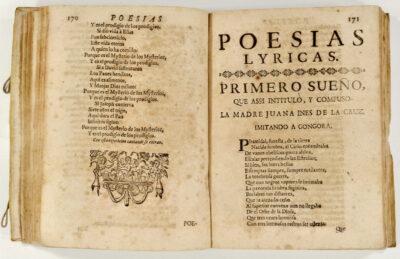
Primero Sueño / “First Dream,” or “The Dream,” sometimes “First, I Dream”
Sor Juana’s poetic magnum opus, Primero Sueño, reflects the Baroque style of her contemporaries, in particular the Spanish Baroque poet Luis de Góngora. For instance, her piece is suffused with metaphors and allegories, creating layers of textual meaning, and is written in silvas, a poetic form composed of varying heptasyllabic and endecasyllabic lines. In theme, narrative progression, and content, Sor Juana’s poem is sui generis, innovating the genre she has taken on (Sabat-Rivers 1976, 1992; Grossi 2007; Gonzalez Díaz 2012; Martha Lilia Tenorio 2019).
Summary
The allegorical poem begins by describing the darkness of night ascending like a pyramid over the world, putting animals to sleep, and allowing the soul to separate from the sleeping body (in Platonic fashion) and ascend toward the heavens to observe the world. The soul seeks universal knowledge, but fails in its initial attempt at total intuitive or sensory knowledge because there is too much to take in. The soul tentatively re-attempts its search for knowledge by using Aristotelian categories of existence; whether this method is successful in the poem remains unresolved. The soul eventually falls back into the body and, incorporated once again, awakens. The final line reveals the gender of the main character: “Yo, despierta” (“I, awake”) as feminine.
Main Issues
The poem is replete with philosophical themes, ranging from the epistemic and metaphysical to the feminist, value theoretic, and theological. The most obvious themes are Platonic—e.g., the positive and productive separation of the soul from the body, the ascent of the soul toward the heavens, and its thirst for universal knowledge stemming from its knowing ignorance—and Aristotelian and Scholastic, e.g., explicit mention of Aristotle’s categories, a Scholastic description of the structure of the body-soul complex, and the idea of incremental, synthetic knowledge being a more productive approach than a wholesale knowing vision. However, there are also clear influences from Hermetic philosophy, for instance, in the mention of the pyramids, an allusion to Jacob’s ladder, and the emphasis on the desire for worldly knowledge as a vehicle for divine knowledge. Some authors note an influence of early modern philosophy on the poem in how it treats skepticism, explores dreaming as an epistemic state, and questions the relationship between empirical and rational processes for learning. Many authors also highlight the extensive feminist concerns of the poem, from the portrayal of the soul as gender-neutral and rational while belonging to a female body, to the emphasis on female mythological figures, particularly ones transmogrified into beasts for infractions against the gods or as protection from male aggression, and the clear gendering of the night as feminine, a time during which it is possible for a woman, like the owl Nyctimene, to intrude on sacred spaces and seek the nectar of knowledge.
Much of the philosophical scholarly treatment of Primero Sueño centers on which themes, influences, or goals are most prominent in this work, and which reveal the true views of its author. One key question, for example, is how optimistic Sor Juana is about the possibility of knowledge, or conversely, to what degree she is committed to skepticism: although the fall of the soul suggests that complete universal knowledge and divine knowledge may be incongruous for mortals, there are hints that some amount of this knowledge is possible. In order to interpret the poem, we must decide how much it reflects Sor Juana’s Baroque influences and how much it demonstrates her innovation on and divergence from its poetic form. Additionally, we might consider which faculties are portrayed as most productive for the pursuit of knowledge: whether the soul is best served by perception or by inference or conceptual synthesis, or whether it benefits from insight or intuition that can only be gained by dreaming.
Another key question concerns the moral dimensions of the pursuit of knowledge. To what degree is Sor Juana embracing or eschewing this pursuit? Is there, in her view, something illicit in the fact that this pursuit takes place at night, away from the divine oversight of the Sun (a metaphor for the Church, perhaps), thus making the soul’s pursuit of knowledge as disobedient and culpable as Eve’s consumption of the apple? Does the pursuit of knowledge necessarily involve an audacity akin to that of Phaeton, to whom the soul is compared in its foolhardy ascent and eventual failure? Or is the ascent of the soul noble and praiseworthy in its intent, turning the image of Phaeton into a romantic tragic hero, and the ambition of the soul into a sincere and divine attribute in keeping with virtuous humility? The polysemous text seems to make room for contrary interpretations, though recent treatments have emphasized the morality of pursuing knowledge, particularly the importance of intellectual and political liberty (González Díaz 2012; Aspe 2018).
4.2 The Reply to Sor Filotea
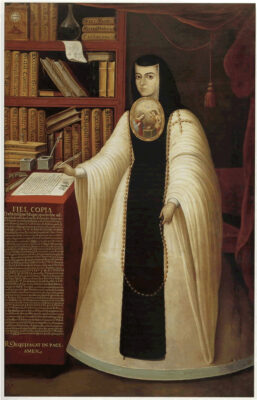
La Repuesta a Sor Filotea / “The Answer,” or “The Reply to Sor Filotea”
This important prose text is an apologia for (or, defense of) Sor Juana’s intellectual pursuits and for women’s intellectual pursuits as a whole. As Arenal and Powell (2009) note, it is formally structured like a 17th-century legal brief, which emphasizes its significance to Sor Juana’s eventual fate and her own awareness of her precarious situation as a well-known female intellectual facing official censure. Use of irony and textual polysemy contribute to the piece’s various changes in tone: from anxious to defiant, and from self-doubting and self-effacing to confident and bold.
An unauthorized publication of her theological treatise Critique of a Sermon thrust Sor Juana into high-level political polemics and attracted the attention of the Inquisition. In view of the imminent danger of censorship or worse punishment by local Church authorities or the Inquisition itself, Sor Juana wrote Reply to Sor Filotea in order to justify her lifelong pursuit of learning and to make a case for women to be allowed to teach other women. Her Reply joined others’ efforts to defend her, including the former Vicereine rushing to publish the second volume of her works in Spain, and some of her friends giving defenses of their own to her Critique of a Sermon (Calvo and Colombi 2015; Rodriguez Garrido 2004; Poot Herrera 1998a; Paz 1982). Nonetheless, these efforts were ultimately futile in preventing Sor Juana’s eventual renunciation of her intellectual pursuits, the sale of her library and scientific instruments, and her signing in her own blood a promise to focus on divine contemplation in the service of God.
Summary
Sor Juana’s Reply begins with her thanking her interlocutor for publishing Critique of a Sermon, introducing some of the charges she faces, and recasting her pursuit of worldly learning as rooted in humility. She then launches into a biographical recounting of her life as concerns her seeking an education, making a case that her thirst for knowledge is innate and not surmountable by force of will, and that her initial aptitude for education was due not to hubris but to genuine love for God’s world and Word. She then moves to defend her study of humanistic arts (such as rhetoric, poetry, logic, law, and hermeneutics and natural philosophy), suggesting that they are necessary prerequisites to understanding scripture and beginning to consider Theology, and that a genuinely humble servant of God seeks a diligent study of scripture before attending to Theology. Sor Juana supports this argument by referencing Aquinas and the ideas of Kircher, those which characterize proper education as like a ladder and the structure of knowledge as interlinked chains which ultimately lead to God. She then acknowledges her own imperfect grasp of these subjects due to her lack of formal education while again referring to her innate and insurmountable desire to overcome her ignorance and the piousness of this desire. She laments that her intellectual life has brought her fame and public hatred, which she suggests is unjust and akin to the Pharisees’ hatred of Jesus’ virtues: wisdom and the love of wisdom are honorable (which is the only part she claims to possess), but they can inspire jealousy or spite from others.
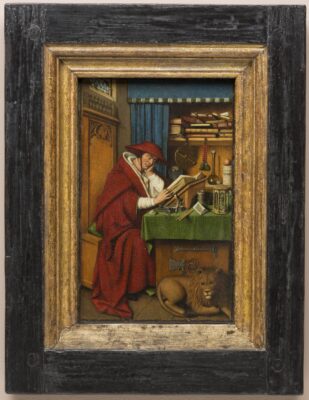
In the second half of the Reply, Sor Juana relates how she once attempted to give up reading altogether. However, she was not thereby able to cease her learning or inquiry, as the world itself served as her book. That is, she suggests that God desires for us to learn about His work, and that He has everywhere peppered opportunities to investigate it – even in the kitchen, where she jokes Aristotle might have been inspired to write still more than he did. After reiterating the impossibility of controlling her desire to learn, Sor Juana notes a long list of women who achieved public renown for their accomplishments from Deborah and other Biblical figures to the Sibyls and Greek and Roman women to women writing on scripture and various female saints. This launches the penultimate section’s vigorous argument against prohibiting women’s study and interpretation of Holy Scripture: she marshals theology, quoting various Church fathers (particularly Saint Jerome) and theological experts (especially Dr. Juan Díaz de Arce), and philosophy, suggesting that what should matter to the permissibility of study is not birthright but rather virtue, which men can lack as well as women. While reiterating her earlier argument that worldly education is necessary for understanding Scripture, Sor Juana then boldly suggests that, in order to avoid the corruption of young women by men, women should receive an education from other women. Finally, she argues that the permissible erudition of female saints like St. Teresa or St. Gertrude is rooted in a more general permissibility for women to study, since many well-regarded women who have written on scripture are not canonized, and many women in the early Church received educations themselves, whether they became saints or not.
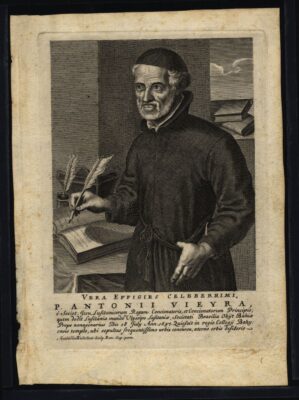
In the last section, Sor Juana defends her specific actions, excusing her poetic writing as generally pious and generated at others’ request. She also frets over the unexpected publication of her Critique by Jesuit priest Antonio Vieyra without her consent, which asserts that the publication was unmerited because her writing was neither very good nor anything more than an unthreatening opinion. Finally, while noting that others have defended her Critique in writing (also without her knowledge), she suggests she will not seek to defend herself directly, preferring to keep silent and receive the criticism of others. She closes with some necessary literary bows and promises to send anything else she writes to her interlocutor for correction first.
Main Issues
The Reply’s central concern is to argue for women’s right to an education, which encompasses the permissibility of Sor Juana’s own intellectual pursuits. To that end, Sor Juana makes many different arguments in both kind and content: appeals to authority, character defense, appeals to precedent, the formulation of new arguments using plausible premises that are both metaphysical and moral, scriptural evidence, theological argumentation, and possibly still others, such as appeals to pathos and pleading a lesser crime than the one charged, e.g., not haughtiness or disobedience, but rather incapacity. Sor Juana believes not only that women should be allowed greater intellectual freedom but also that they should be encouraged to teach each other a great variety of subjects, perhaps even those that men learn and teach. She criticizes the belief that men should be allowed to study Scripture and suggests that men are as prone to error and vice as women are. In this way, she seems to envision a true egalitarianism in the area of learning (although she does not attempt to make a case for women earning any rights held specifically by ordained priests, or leadership positions within the Church, which probably would have been beyond heretical to argue).
Besides the centrality of this feminist or proto-feminist theme, the topics treated in the Reply are quite broad in philosophical scope. One set of prominent issues is epistemological and pedagogical: what is Sor Juana’s view of the structure of knowledge or justification, how are the different disciplines of knowledge arranged, and how deeply committed is she to a Thomistic picture of proper pedagogy? Her text suggests that, because errors in interpreting Scripture can amount to heresy, it is more virtuous to begin learning other subjects, for which infractions are minor (e.g., epistemic or aesthetic mistakes, rather than moral ones). This connects to another question regarding the achievability of divine knowledge: Sor Juana tends to portray the divine not as immediately knowable (certainly not knowable by introspection) in comparison to the mysticism of Saint Teresa or the deductive or intuitive knowledge of God in Descartes. On the whole, Sor Juana’s view seems to be that studying the “profane,” or mundane, arts is not only more permissible, but also more accessible, than studying divine matters. This grounds her pedagogical view: a good education must begin with an education in arts and letters and even in natural philosophy, as this will help make the interpretation of Scripture possible and make it less likely that one will commit heresy by misreading Scripture.
This also pertains to her views on justification. The Reply does not portray the kind of skepticism that seems viable in her First Dream. For example, Sor Juana suggests that her natural inclination towards learning might be God’s doing, as the worldly objects around her that God made each cry out for investigation. This suggests that a certain kind of dogmatism might be warranted, according to which a properly oriented and virtuous subject might be able to attain justified true beliefs about the created material world by the use of their own faculties. Although this requires effort, and similar to a Hermetic perspective (Kircher), the Reply does not portray worldly knowledge as unattainable in the way that it portrays divine knowledge. Some theorists suggest that Sor Juana may have been influenced by the 15th-century theologian Nicholas of Cusa (Olivares Zorrilla 2014), though she does not cite him.
Sor Juana’s letter contains some metaphysical assumptions. For her, as for any Catholic, God is the source and grounding of the perceivable world. Furthermore, in Hermetic fashion, all things in the world are connected and point to the Creator. However, in spite of the emphasis on learning and knowledge that is reflected in the Reply, and the importance of the subject to Catholic writing, the soul or the mind and its structure, its rationality, and its relationship to God are not mentioned in this piece, despite its central place in her First Dream. This is a curious omission, given the prominence of Plato’s defense of women’s rational souls in his Republic and Sor Juana’s evident familiarity with Classical sources, as well as the discussion of souls by various male writers in the Church and by Saint Theresa (whom she cites). Perhaps the rhetorical value of using this argumentative angle would have been negligible: establishing the rationality of women’s souls would have required an entire metaphysical treatise, possibly arguing against Aristotle and certain prominent thinkers that followed him, and might have further hindered Sor Juana’s cause. In effect, there is no accounting of the various mental faculties or how each is positioned with respect to potentially knowable propositions.
Instead, Sor Juana names a variety of virtues that are relevant to the issue at hand, shifting the focus from the metaphysics of the soul to an accounting of moral psychology. We might ask whether the virtues she mentions are best characterized as moral virtues, intellectual virtues, or both. For example, Sor Juana’s discussion of humility positions this as a central virtue, necessary for avoiding both moral error and epistemic or intellectual error. Similarly, other virtues—piousness, self-knowledge, diligence, self-control, assiduousness, honesty, reverence, obedience, and wisdom—are cast as both moral and intellectual. Even chastity is relevant for the pursuit of intellectual goods, as Sor Juana suggests that women would more likely be chaste if they would be allowed to teach each other. It seems Sor Juana does not characterize virtues as exclusively moral or intellectual, given that holistic virtues are necessary for proper conduct befitting a person of faith. That said, she does see a difference between moral value on the one hand and epistemic and aesthetic value on the other: moral faults can be truly reprehensible and dangerous, while epistemic faults should be censured but not be damnable, and aesthetic faults should just be ridiculed or ignored. We can ask, then, whether the vices make for this differentiation if the virtues that help prevent these errors are not distinct.
4.3 Spiritual Self-Defense
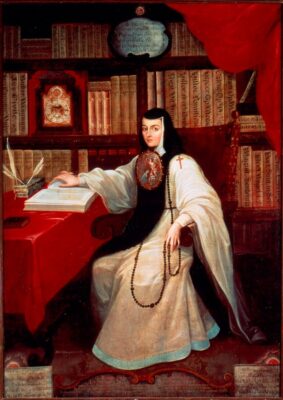
Autodefensa Espiritual / Letter to her Confessor: Spiritual Self-Defense
The discovery of Sor Juana’s strikingly frank letter to her Confessor Antonio Núñez de Miranda, in which she dismissed her own assigned Confessor for his public criticism of her, sent shockwaves through modern scholars for its exegetical implications. Her clear authorial voice in this letter, largely lacking the Baroque stylings of many of her other works (which can prove challenging to interpret), sets it apart and allows us to distill her moral inclinations and self-understanding more directly. The letter can be seen as anticipating or rehearsing the themes seen in her later letter to Sor Filotea (the Reply): the compatibility between her intellectual pursuits and her faith, the right of women to private study, women’s rationality, and a defense of her own scruples and conscience in the face of public scrutiny.
As Stephanie Kirk (2017) reminds us, Sor Juana challenges her confessor, who believed men to be governed by otra razón, or “a different reason,” to defend the dichotomy between study and salvation. In her most poignant lines, she declaims, “But who has prohibited women private and individual studies? Do they not have a rational soul like men? Why should it then not enjoy within them the privilege of enlightenment in an education? Is it not as capable of earning God’s glory and grace as yours? Why should it not be capable of such news and science, a trifle? What divine revelation, what determination of the Church, what dictate of reason made for us such a severe law?” (translated from Tapia Mendez 1993).
Sor Juana is self-assured in this letter, confident in her own abilities and respectability, pointed in her charges against her confessor, and disappointed in the poor rationale for the Church (and Núñez’s) insistence on women’s subjugation. This letter makes it clear that Sor Juana was able to stand up for herself and did not easily conform to social expectations. She weighs the significance of her female forebears, such as Saint Paula, and carves space for herself as a female intellectual who still upholds the Catholic faith.
4.4 The philosophical-moral Sonnets
Though Sor Juana composed various sonnets for numerous occasions, eight sonnets have been traditionally grouped together and labeled as “philosophical-moral.” These sonnets either purport to offer moral guidance or provide moral justification for decisions one might make in challenging circumstances. Collectively, these sonnets provide a glimpse into her ethical views (elaborated below) as she systematically casts light on various attitudes or feelings she regards as morally detrimental (e.g., vanity, ambition, fear of death, and hope) and then offering either guidance to avoid falling prey to them or justification to adopt other beneficial orientations.
Summary
The first sonnet describes a flattering portrait of Sor Juana, full of praises and compliments, which Sor Juana then disparages as “vain artifice” that does not protect against the vagaries of fate. The second sonnet voices Sor Juana’s complaint against the world’s hostility towards her and defends her orientation and attitudes. The third sonnet portrays a rose that, despite all of its beauty and perfection, is ultimately subject to the indignities of decay and corruption. The fourth sonnet puts in scene a character, Celia (an alter ego of Sor Juana), who addresses a rose in a meadow, morally advising it to enjoy beauty and life, since dying while still beautiful is preferable to suffering the indignities of old age. The fifth sonnet advises against living a life in which one avoids all risks. The sixth sonnet expresses Sor Juana’s complaint that her poetic gifts and abilities have made her the target of insults and offenses. Finally, the last two sonnets address the illusory and deceitful nature of hope, warning the reader about the entrapments and suffering which can befall people.
Main Issues
Though they do not offer systematic ethical guidance, the philosophical-moral sonnets nevertheless function as a series of signposts indicating potential moral pitfalls and shortcomings that human beings (and women especially) may face. In light of this, one can think of the philosophical-moral sonnets as depicting different character traits or attitudes and showing how they lead to certain outcomes without offering a prescriptive framework for actions. Thus, the philosophical-moral sonnets present both limits and advantages in their form, structure, and tone: they do not offer (and they do not aim to offer) a systematic or universal account of ethics but, through their brevity and narrow focus, they offer readers an opportunity to engage in a sharpened moral reflection that is perhaps more effective for pedagogical purposes than a long treatise.
As noted earlier, the philosophical-moral sonnets critique such dispositions as vanity and ambition, fear of death, and hope. For instance, a common theme in the first and sixth sonnets is the danger of possessing beauty and intellectual or poetic talents. Indeed, according to Sor Juana, both physical beauty (which she describes as a “colorful deceit”) and the intellectual and poetic talents (which she describes as “gifts” that elicit approval) have a dark side: they may either promote a sense of physical or intellectual vanity in those who have them, or they may elicit envy and fuel resentfulness in those who are deprived of them. As such, these sonnets can be seen as echoing Socrates’ warnings about the moral dangers of the public spotlight. In the fourth and sixth sonnets, Sor Juana exhibits an Epicurean streak through her emphasis on enjoying life while it lasts and taking risks, since all worldly things are time-bounded and perishable. Finally, in the seventh and eighth sonnets Sor Juana warns against hope, which can lead to self-deception about the nature of things and our capacity to change them. Her views predate those of 20th-century scholars such as Derrick Bell and Roger Scruton, who have written about the perils of hope in the personal and political sphere.
4.5 The Trials of a House & Love is a Labyrinth
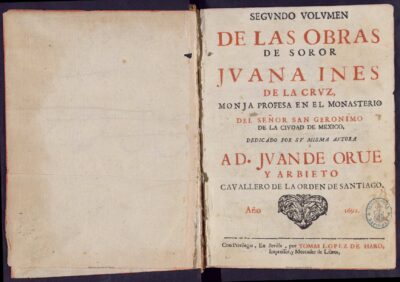
Los Empeños de Una Casa / “The Trials of a House”
Amor es Más Laberinto / “Love is a Labyrinth”
Summary of “The Trials of a House”
Pedro and Ana de Arellano are wealthy noble siblings who relocated to Toledo from Madrid. The play begins with Ana and Celia, her maid, waiting at night for Pedro’s arrival. As they wait, Ana mentions that she is beginning to fall in love with the handsome Carlos de Orellano despite having a young admirer named Juan de Vargas who loves her.
Suddenly, a group of masked men enter Ana’s house with a young woman who is entrusted to her care. The young woman is Leonor, a noble, beautiful, and educated lady (who functions as the alter ego of Sor Juana: see Luciani 2004). In a lengthy monologue, Leonor explains that she has feelings only for Carlos despite attracting many other suitors and admirers. Rodrigo, Leonor’s father, unfortunately disapproves of their union because he wants a wealthier husband for her. Undeterred, the two young lovers attempt to elope. They are intercepted by two men while escaping. They had been misinformed by Pedro (who desires Leonor for himself) that Leonor was being taken away against her will. Carlos fights with the men and wounds one of them (Diego, Leonor’s cousin). This scuffle prompts the second man to call for reinforcements, who promptly arrive. Moved by Leonor’s pleas, Carlos surrenders, and Leonor is taken away to another room by the masked men, who are commanded by Juan.
Ana schemes to keep Carlos and Leonor apart after learning that Leonor is her rival for Carlos’ affections. Carlos and his servant Castaño arrive at the Arellanos’ house, having escaped from law enforcement, and ask Ana for shelter. Ana lets them in, but puts them in a room away from Leonor. In the meantime, Rodrigo finds out from his servant Hernando that Leonor has eloped and complains about the shame that her actions have brought to her and her family. Rodrigo goes to Pedro’s house to arrange a marriage between Pedro and Leonor, believing that Pedro is behind the elopement. Back at Pedro’s house, Juan, who has been covertly snuck in by Celia to woo Ana, addresses Leonor in the dark (believing that she is Ana). He attempts to seduce her, but Leonor turns him down. Ana brings Carlos with her to the dark room to persuade him that Leonor is unfaithful to him and, at the same time, to convince Leonor and Juan that Carlos is really in love with Leonor. When Celia brings a lantern, Leonor and Carlos recognize each other, and Juan recognizes both. Juan threatens to kill Carlos, but before he can act, Pedro arrives at the house. To avoid a scandal, Ana instructs Celia to hide Juan, Carlos, Castaño and Leonor in different parts of the house. When Pedro finally gets to Ana’s room, he tells Ana that he wants her help to seduce Leonor and disrupt her relationship with Carlos. Ana mischievously agrees.
Carlos later confides in Castaño that he’s still in love with Leonor, despite having seen her in a compromising situation. Ana visits Leonor. Leonor, still ignoring who she is and that she is infatuated with Carlos, expresses to Ana her gratitude for giving her shelter. Pedro reveals his identity to Leonor and, with Ana’s help, attempts to seduce her by making her believe that Carlos has forsaken her. Meanwhile, Celia guides Carlos and Castaño to a fence gate where they can see Pedro wooing Leonor. Carlos witnesses the scene but refuses to give in to jealousy before finding out why Leonor is at Pedro’s house. Celia, following Ana’s orders, deceives Carlos, telling him that Leonor is there because she has accepted Pedro’s advances. Carlos refuses to believe Celia and surmises that Leonor is in the house against her will. He plots to free her and hides again with Castaño behind the gate. While hiding, Carlos sees Rodrigo arriving at Pedro’s house to ask for Leonor and to demand that Pedro marry her to restore her honor. Pedro lies about Leonor’s whereabouts but says that he is ready to wed her at the earliest opportunity. This reassurance calms Rodrigo, who departs to make arrangements for the marriage. Though Carlos momentarily despairs after hearing this exchange, Castaño advises him to persevere in his efforts.
After discovering that she is to be married to Pedro, Leonor confesses to Celia that she would rather die. She pleads with Celia to let her go. In the meantime, Carlos devises a plan to thwart the wedding: because Carlos cannot go out of the house unnoticed, he orders Castaño to take a note to Rodrigo informing him that it was Carlos, and not Pedro, who orchestrated the elopement, so that Rodrigo can give him blessing to restore Leonor’s honor. Castaño doubts that he will be able to deliver the note without being recognized, so he disguises himself in Leonor’s clothes. Disguised, Castaño runs into Pedro, who mistakes him for Leonor and keeps making advances. Castaño promises to marry him that night in order to get rid of Pedro. Pedro swears he will henceforth care for Leonor.
Carlos and Juan suddenly barge into the room, ready to fight each other, with Ana trying to stop them. Angered at both for fighting in his home, Pedro bellows that he will kill them. Castaño blows out the candle to defuse the confrontation. Carlos confuses Leonor with Ana in the dark and out of a sense of honor and gratitude for having previously offered him shelter, takes Leonor away from the scuffle to protect her. Ana helps Juan to sneak away, believing him to be Carlos. Still under the impression that Leonor is Ana, Carlos delivers her to Rodrigo for her safety and returns to Pedro’s house to rescue her. Believing her to be Ana, Rodrigo then returns Leonor to Pedro’s house as a sign of good faith, under the condition that Pedro will honor his promise and marry Leonor. Because Carlos had displayed concern and care for a veiled Leonor, Rodrigo comes to believe that Carlos loves Ana, and he advises Pedro to marry her to Carlos. Pedro promptly agrees.
When Carlos enters Pedro’s house looking for Leonor and sees Rodrigo (who tells him that he is going to reward him), he comes to believe that Castaño has delivered the note and that Rodrigo will allow him to marry Leonor. But when he is presented with the veiled Leonor (whom he still believes to be Ana), he vehemently refuses the marriage, stating that his heart belongs to Leonor. Juan and Ana then enter and Ana professes her love for her companion, whom she still believes to be Carlos. When she realizes her error, she decides to finally give up Carlos and be with Juan. Castaño arrives, still dressed as Leonor, and the real Leonor lifts her veil, revealing her identity to an overjoyed Carlos and a befuddled Pedro, who cannot understand how there can be two Leonors. When Castaño reveals his ruse, Pedro is furious and threatens to kill him. Castaño, however, shames Pedro by reminding him that he had promised to care for him when he believed Castaño was Leonor. The play ends with Leonor marrying Carlos and Ana marrying Juan with the respective blessings of Rodrigo and Pedro.
Summary of “Love is a Labyrinth”
The action takes place in Crete, within the palace of Knossos, where King Minos rules. Because the son of Minos, Androgeous, had died as a result of the envious machinations of Aegeus, king of Athens, Minos has invaded and subdued Athens, and has imposed as a peace condition a yearly tribute of seven young men and seven young women selected randomly to feed the Minotaur. As they await the yearly tribute to arrive, the two daughters of Minos, Phaedra and Ariadne, listen to music that has been brought to them by two suitors visiting Minos’ court: Lidorus, prince of Epirus (who loves Phaedra), and Bacchus, prince of Thebes (who loves Ariadne). Minos informs his daughters that this year, chance has determined that Theseus, prince of Athens and son of Aegeus, will be one of the young men offered in tribute. Because he is a prince, Theseus is accompanied by Atún, his servant, and he is introduced to Minos by the ambassador of Athens. When Theseus is brought into the presence of Minos, he and Phaedra are immediately smitten by each other’s beauty, and Ariadne also falls in love with him. Theseus recounts to Minos all his prior feats and glories, and he says that he would gladly give his life to Minos in exchange for Athens being freed from the yearly human tribute. Minos refuses, despite pleas for mercy from the ambassador of Athens and others. Both Phaedra and Ariadne resolve to help Theseus escape from his fate. Phaedra approaches Theseus to confide her intention of helping him to escape, but she is overheard by Ariadne, who vows to thwart her sister’s efforts so that she herself can help Theseus and win his affections. Atún woos Laura, Phaedra’s maid. Bacchus overhears the words of Ariadne as she vows to save Theseus, but he misunderstands her and comes to believe that she has developed feelings for Lidorus. Racimo, Bacchus’ servant, advises his master to woo Phaedra in order to spite Ariadne. Lidorus overhears Bacchus attempting to seduce Phaedra, and challenges him to a duel. As they are about to fight, Minos intervenes to stop the quarrel.
After Theseus kills the Minotaur and exits the Labyrinth with the help of Ariadne, he is in debt to her. Laura and Cintia, Ariadne’s maid, approach him and give him an armband and a feather, respectively, so that Phaedra and Ariadne will be able to recognize Theseus at the palace dance that night. Theseus, wearing the armband, goes to the dance accompanied by his servant Atún, who wears the feather. Initially, Theseus dances with Phaedra, while Bacchus dances with Ariadne, Lidorus dances with Laura, and Atún dances with Cintia. As they all dance, Atún drops the feather, which is picked up by Bacchus. Bacchus recognizes it and, wondering in a fit of jealousy whether Ariadne is interested in Lidorus, puts the feather in his hat. Phaedra recognizes the armband and tells Theseus to meet her later. Ariadne recognizes the feather and does the same with Bacchus, suggesting the same location at which Phaedra will meet Theseus.
Later that night, Phaedra and Ariadne wait for their respective lovers in the dark. Theseus arrives first, but he confuses Ariadne with Phaedra and starts to woo Ariadne. Phaedra overhears the conversation and gets furious, but before she can do anything, Bacchus arrives. He mistakes Phaedra for Ariadne and starts to seduce Phaedra. Because Phaedra is aware that he is not Theseus, she rejects Bacchus. Bacchus still believes Phaedra is Ariadne, and he accuses her of being in love with Lidorus. Meanwhile, Ariadne realizes that Theseus is interested in Phaedra and departs abruptly, leaving Theseus frustrated. Theseus fights briefly with Bacchus but hides after the noise of the fight attracts attention. Lidorus arrives, planning to kill Theseus because he thinks Theseus is pursuing Phaedra. Bacchus and Lidorus scuffle, but as Cintia and Laura bring lights, they recognize each other and stand down, while Phaedra and Ariadne complain about the labyrinthine nature of love.
Racimo, Bacchus’ servant, is told to deliver a note to Lidorus to challenge him to a duel, but he mistakenly gives the note to Atún, whom he believes to be Lidorus‘ servant. Theseus demands that Atún give him the note, believing it to be a written response from Phaedra. Theseus mistakenly believes the note to be addressed to him by Bacchus, so he goes to the dueling rendezvous to avenge his honor. He kills Lidorus and then hides, believing that he has killed Bacchus. Bacchus and Thebandrus simultaneously arrive and see Lidorus agonizing. Thebandrus believes that Bacchus killed Lidorus after retrieving the challenge note, but because Bacchus is a foreign prince and has no jurisdiction over him, he lets him go. Bacchus decides to leave Crete, fearing for his safety, but he also resolves to take Ariadne with him. Theseus and Phaedra also decide to leave Crete together and escape to Athens. Both Theseus and Bacchus go to the harbor to prepare their respective ships but when they return to the palace, the darkness causes Theseus to grab Ariadne while Bacchus takes Phaedra. Because the two couples are next to each other, Phaedra overhears Atún speaking to Theseus and realizes the error. Phaedra runs to Theseus’ side, while Ariadne is bemused.
As Theseus and Bacchus are about to fight each other, Racimo arrives, pursued by Thebandrus and the rest of the royal guard. Thebandrus apprehends everybody and summons the king. Minos arrives and orders Thebandrus to lift the veils that hide the faces of Phaedra and Ariadne. Enraged after recognizing them, Minos vows to punish them both. After witnessing this exchange, Bacchus and Theseus remove their face covers, revealing their identities, and plead for Minos to punish them instead. A vengeful Minos orders everyone to be executed. Before his orders can be followed, a group of Athenian soldiers led by the general Licas barges into the room and announces that Crete has been occupied by an Athenian expedition sent to avenge Theseus. Theseus urges mercy as Licas is about to kill Minos. Grateful, Minos offers Phaedra to Theseus and Ariadne to Bacchus in matrimony. The play ends with Racimo and Atún confessing their roles in the note mix-up and gaining, respectively, the affections of Cintia and Laura.
Main issues in “The Trials of House” & “Love is a Labyrinth”
Sor Juana’s two secular comedies are representative of the Spanish Baroque theatre. Both are rich in contrasts among the characters themselves, e.g., the integrity and love constancy of Leonor on one hand, and the duplicity and fickleness of Ana on the other. They are also characterized by tensions brought about by the specific circumstances that the characters face, including the love rivalry between Phaedra and Ariadne. In these respects, Sor Juana’s comedies exhibit parallels to the work of other Baroque playwrights such as Lope de Vega, Pedro Calderón de la Barca, Tirso de Molina and Juan Ruíz de Alarcón. Like Tirso de Molina, Sor Juana often creates female protagonists who command the play far more than the male characters. Similar to the plays of Ruíz de Alarcón, Sor Juana’s comedies have a moralizing streak insofar as they portray the triumph of virtue and the punishment of evil and vice. In contrast to the work of her male playwright counterparts, however, Sor Juana’s comedies have more of a philosophical dimension (in particular, they exhibit a sustained concern with issues in moral psychology). This dimension is evident in three primary ways: (1) the comedies provide clear examples of characters engaging in complex moral reasoning; (2) they characterize the roles of certain emotions—in particular, shame, love and jealousy—in eliciting certain moral or immoral behaviors; and, (3) they provide a model of a proto-feminist ethics of care centered on values and dispositions such as attentiveness and responsibility.
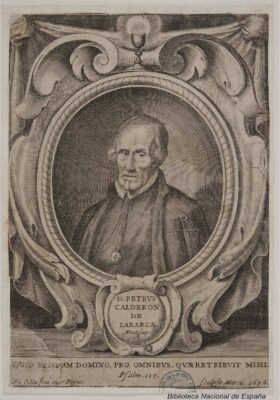
Characters who engage in complex moral reasoning include Carlos in The Trials of a House after he witnesses Pedro wooing Leonor and the ambassador of Athens in Love is a Labyrinth as he tries to persuade Minos to show mercy to Theseus. Indeed, after Carlos observes Pedro attempting to seduce Leonor, he is deeply shaken and faces a moral dilemma: should he forsake Leonor as an unfaithful lover, or should he keep loving her and find an alternative explanation for what he has seen? Carlos exercises his moral reasoning by reflecting on the fact that he himself has come to be in Pedro’s house because of an unusual confluence of accidents (e.g., his attempt to elope with Leonor was thwarted; he was forced to escape from law enforcement officers; and he found refuge in the Arellanos’ house thanks to Ana). He considers that Leonor’s presence is perhaps also due to circumstances beyond Leonor’s control, which is in fact the case. He further reasons that, if Leonor has been accidentally brought there, and if he doesn’t intervene when Pedro attempts to woo her, he would be forsaking his duty as a gentleman.
In the case of Love is a Labyrinth, Minos is faced with the moral dilemma of either avenging his son Androgeus by killing Theseus or being magnanimous and sparing him. The ambassador of Athens reasons that Minos should show mercy because Theseus’ death will not bring back Androgeous, because Theseus surrendered honorably to Minos after the defeat of the Athenians, and also because by showing mercy, Minos will be better avenged, for Theseus will be permanently ashamed and in debt to his enemy.
From the perspective of moral psychology, Sor Juana’s comedies also provide case studies of how emotions elicit various kinds of moral or immoral behavior. In The Trials of a House, Ana provides a magnificent example of how jealousy operates. Because she is jealous of Leonor, Ana understands well the power of jealousy. In a brief aside, she explains her plan to make Carlos observe Pedro wooing Leonor. Ana is aware that jealousy can be implanted only in a mind filled with doubt, so she cunningly creates a situation that will make Carlos uncertain about the strength of Leonor’s love toward him. Moreover, since Carlos considers Leonor his future spouse, Ana mentions that if she is successful in making Carlos jealous, the jealousy will operate differently than if Carlos were starting to court Leonor. As Ana puts it, while jealousy might cultivate a budding romance, it will cause spite and heartbreak in an established relationship.
Love is a Labyrinth also provides an example of how shame can motivate moral behavior. When Minos orders Thebandrus to lift the veils of Phaedra and Ariadne, both are overwhelmed by shame at being recognized and exposed in such a public manner, and Bacchus experiences shame about his beloved Ariadne being in such a compromised position. Accordingly, he removes his face cover and, taking full responsibility for Ariadne’s actions, pleads with Minos to punish him rather than Ariadne. Theseus then feels ashamed about himself because Bacchus had the courage to sacrifice himself to save Ariadne from Minos’ wrath. He removes his face covering, and, taking responsibility for Phaedra’s actions, he pleads with Minos to punish him rather than Phaedra.
Finally, Sor Juana’s comedies articulate a proto-feminist ethics of care centered around values such as attentiveness and responsibility. In this way, they represent an important antecedent to the work done by Nel Noddings, Joan Tronto, and other care ethicists. This quality is particularly visible in Love is a Labyrinth when Phaedra and Ariadne strive to care for Theseus by shielding him from Minos and doing what they can to help him escape. As Sor Juana makes clear, the care that both Phaedra and Ariadne direct to Theseus emerges first as a result of infatuation. Both Phaedra and Ariadne are smitten by Theseus’ handsome countenance as well as his moral courage. At the same time, they become aware of his vulnerability to death. Phaedra and Ariadne become infatuated with him, and this feeling displaces all other motives for action (e.g., their love for their father or their country). This infatuation and motivational displacement, which are necessary characteristics to engage in care (Nel Noddings 1984), lead both women to care about Theseus’ need—in particular, his need to survive. Phaedra tells Theseus that “me importa que viváis” (“I care that you live”) and that she will find a way to save his life no matter the cost.
In addition to the development of attentiveness, the play shows how people develop an attitude of responsibility. Though Ariadne actually saves Theseus by helping him kill the Minotaur and escape the labyrinth, Theseus later kills Lidorus in a duel due to a misunderstanding. Afterwards, Ariadne worries that, while her initial actions enabled Theseus to escape death (and made her feel responsibility for his life), his killing Lidorus will put him again in harm’s way. She resolves to escape with him, relinquishing her claim to the throne of Crete, in order to fulfill her responsibility for care toward him and toward herself: “(…) pues con huir/ a él lo libro de morir,/ y a mí de morir con él;/ de manera, que fiel/ a los dos soy este día” [“(…) by fleeing/ I save him from death/ and I save myself with him/ thus, I am faithful/ to the two of us today”].
4.6 Allegorical Neptune
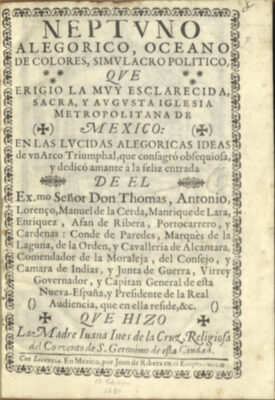
Neptuno Alegórico / “Allegorical Neptune”
Summary
The Allegorical Neptune is an elaborate text that Sor Juana wrote in 1680 to celebrate the arrival in Mexico City of the new Viceroy, Tomás de la Cerda y Aragón, marquis of La Laguna, and his wife María Luisa Manrique de Lara y Gonzaga. To honor their arrival, the Metropolitan church authorities decided to erect a triumphal arch in which the Viceroy and his wife were represented as the Roman god Neptune and his wife Amphitrite in several large paintings hung from the arch’s facade. To accompany and complement the gift of the arch, Sor Juana was commissioned to write a text not only explaining why Neptune and Amphitrite were chosen to represent the Viceroy and Vicereine, but also describing each of the paintings on the arch. Furthermore, the text was to provide extensive commentary on each painting, highlighting its connection with either feats accomplished by the Viceroy or virtues that his character and life illustrated. The Allegorical Neptune is comprised of three main parts: a dedicatory preface, “Reason of the Allegoric Fabric and Use of the Fable” in prose, and an “Explanation of the Arch” in verse.
Main Issues
Though the Allegorical Neptune has traditionally been considered a minor work in contrast to First Dream, or “The Answer,” because it was written as a circumstantial piece celebrating a political figure (Paz 1988), it is not just an elaborate collection of flatteries adorned with mythological and historical allusions or an overextended rhetorical exercise in praise. From a philosophical perspective, the Allegorical Neptune is an interesting work for at least two reasons. First, from a socio-political viewpoint, Sor Juana uses the piece to advocate for various public works that would improve the safety and well-being of the inhabitants of Mexico City. In particular, Sor Juana points out that, because the Viceroy is (qua Neptune) master of the waters, he should use his talents to protect Mexico City from a series of devastating floods by building an effective drainage system (Mexico City flooded frequently because it was built on an island within a basin containing several shallow lakes). In addition, Sor Juana cites Virgil and Ovid, whose works credit Neptune with the building of Troy’s walls, to point out that Neptune was also associated with architecture and building. Sor Juana therefore encourages the Viceroy Tomás de la Cerda to engage in an ambitious construction program in Mexico City that would include the completion of the Metropolitan Cathedral.
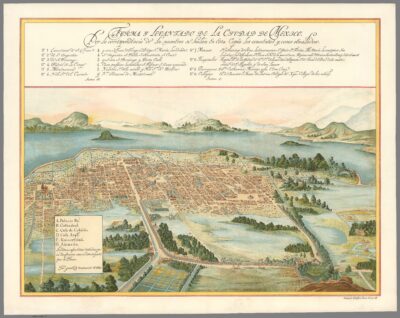
Sor Juana refers to Mexico City in the Allegorical Neptune as “the head of the Occident” (“la Cabeza de Occidente”) and an “Imperial Mexican wonder” (“Imperial Mejicana maravilla”), suggesting that she is profoundly aware and proud of the political and cultural importance of Mexico City. She implies that, because of this importance, Mexico City (and New Spain, by extension) deserve care and protection against both the natural elements and other threats. In making this argument, Sor Juana exhibits a consciousness that is based upon a socio-political identity distinct from that of Peninsular Spaniards and that expects the acknowledgement and respect of certain rights (López Cámara 1957).
Secondly, from an ethical viewpoint, the Allegorical Neptune functions as a manual of moral advice written for a noble figure, which makes it similar in some respects to Fénelon’s The Adventures of Telemachus. Deeply influenced by conventional formulas of praise, Sor Juana offers to the Viceroy a series of suggestions to realize the idealized representation of himself as Neptune by governing as a virtuous and compassionate ruler. For example, she reminds the Viceroy that Neptune touched the drifting island of Asteria with his trident, allowing it to become temporarily fixed so that Leto could use it to give birth to Phoebus and Diana. In parallel to this story, Sor Juana suggests that, by using his pen to sign compassionate laws rather than punitive ones, the Viceroy can provide New Spain with order and stability, which will allow the arts and sciences to flourish. Sor Juana emphasizes that, just as Neptune offered refuge to the Centaurs (symbols or vessels of wisdom) from the murderous wrath of Hercules (who stands here for barbarous irrationality), the Viceroy can become a patron of poets and scientists in New Spain by defending them against obscurantist figures and irrational movements in both government and Church.
4.7 Critique of a Sermon
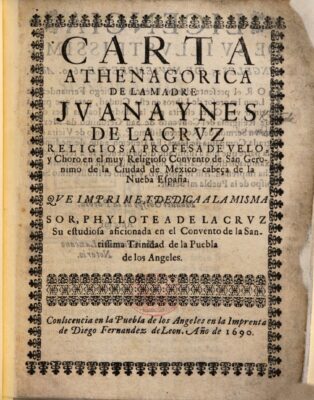
Carta Atenagórica / “Critique of a Sermon”
One of Sor Juana’s most important prose works, her critique of a sermon by Antonio Vieyra was called the Letter Worthy of Athena by its publisher (the Bishop of Puebla, Manuel Fernández de Santa Cruz). Here, we see Sor Juana’s logically rigorous and erudite treatment of a major Christian theological issue, the meaning of Christ’s sacrifice. In writing on this topic and criticizing the work of a renowned priest, Sor Juana also defies conventions about what subjects are appropriate for women’s writing and what activities are appropriate for women’s engagement. The publication of this critique caused a political firestorm, and commentators still dispute the exact political intent of its publisher, who the intended target of the publication was, and the political ramifications for both Sor Juana’s life and for her critics. Whatever the case may be, the critique outlived her, and it was memorable enough to be published in some editions of Vieyra’s sermon and accompanying commentaries after her death.
Summary
Sor Juana grounds her argument in the authority of three major Church fathers, Augustine, Aquinas, and Chrysostom, each of whom Vieyra himself was disagreeing with. Vieyra wrote, “The style in which I will conduct this discourse will be this: I will refer first to the opinions of the Saints, and afterwards I will[?] also say my own, albeit with this addition: no demonstration of the love of Christ will be noted by the Saints for which I will not give one still better; and none will find, for the demonstration of[?] Christ’s love that I will declaim, a one that exceeds it.” Sor Juana opens her critique by remarking that Vieyra is more daring than even herself, and she casts her response as a simple defense of her superiors rather than an act of hubris. She understands how her work will be perceived, and scholars have confirmed that Sor Juana intends, in part, to criticize theological arrogance (Powell 2011; Aspe 2018). What follows is a general summary of the disagreement between Sor Juana and Vieyra.
Augustine had written that the greatest of Christ’s demonstrations of his love was to have died for the sake of mankind. Sor Juana agrees with Augustine and disagrees with Vieyra, who thinks that Christ’s absence proves to be a greater demonstration of his love than his death. Vieyra argues that absence was more painful for Christ, for which the proof is that Christ sought more remedies for it through the sacraments.
Firstly, Sor Juana supports Augustine’s claim that Christ’s greatest excellence was his death. She notes that Christ reminds us to remember his death, not to remember that he has raised us, or that he was incarnated as a man, or that he was transformed into the bread of sacrament. Vieyra responds to Augustine by declaring that “Our Lord loved mankind more than life itself, and to die is to leave life behind, to depart is to leave mankind.” Sor Juana replies that Jesus has not departed: he remains present in the Tabernacle, even in death.
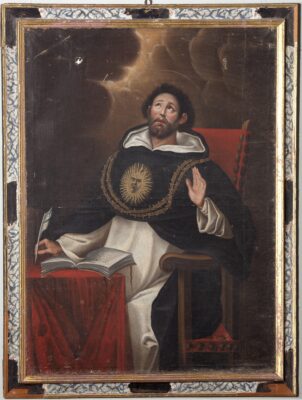
Secondly, as she notes for Aquinas, Christ’s greatest demonstration of love was remaining with us even while departing from us. Vieyra argues, to the contrary, that only Christ’s body remains present and that it is a kind of torment for him not to be able to commune with his beloved humanity, as this body lacks sensation; and that this makes Christ’s demonstration of love more magnanimous. Sor Juana calls this argument sophistry on the basis that Aquinas’ argument regards the genus and Vieyra’s only the species, and she gives specific counterexamples that respond only to Vieyra’s examples.
Thirdly, Chrysostom wrote that Christ’s greatest demonstration of love was that he washed the feet of his disciples, including those of Judas. Vieyra writes that Christ’s greatest demonstration of love was not the washing itself, but rather what moved him to do it. Sor Juana replies by pointing out that the cause and effect were not separated by Chrysostom, so they must be taken as a unit, and it makes no sense to raise one above the other. She considers that the act of washing, in its full context, must have had multiple confluent causes. Furthermore, Sor Juana notes, having love is not as noble as demonstrating love, and this is why Chrysostom highlights the action of Christ rather than His motivation.
Finally, there is the issue of whether God’s love sought correspondence. Vieyra opines that Christ’s love seeks neither cause nor effect but that it shows love for love’s sake. Because it does not seek correspondence, in Vieyra’s mind, it is Christ’s greatest demonstration: a freely given and unconditional gift. Sor Juana suggests that instead, Christ does seek correspondence of His love. She cites strong textual evidence from Matthew 22:37 where Jesus commands us to love God as his first mandate. Sor Juana argues that Christ desires for humans to share their love with one other and thus reflect their love for God. He intended this requirement of love for the benefit of humanity. Sor Juana goes on to argue that Christ’s perfection rules out his need for human love, for he is not lacking. Christ asks Simon Peter if he loves him, and when Peter says yes, Christ directs him to feed his lambs.
In the closing section of her criticism, Sor Juana explains that what she sees as the greatest of the demonstrations of God’s love are “negative” ones: those benefits God does not give us, knowing how ungrateful we would be and how we would fail to meet our obligation to correspond his love. She writes, “Let us thank and ponder this delicacy of Divine Love in which awarding is a benefit, punishment is a benefit, and suspending benefits is the greatest benefit, and not making demonstrations is the greatest demonstration.” God’s existence is sufficient to benefit mankind, which in itself ought to be sufficient to inspire love and goodwill toward one another and also express gratitude toward the Creator.
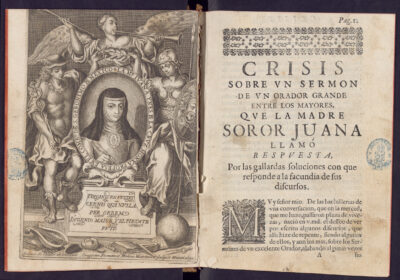
Main Issues
Besides the biographical context of the piece, Sor Juana’s critique of Vieyra’s sermon is notable for its deft use of Scholastic argumentation to prove a theological point. Another reason it is notable is that Sor Juana, while nominally defending the orthodox views of three Church fathers, is introducing novel rationales for them and possibly sneaking in new theology as well. She provides theories of causation, desert, the human condition, the value of love, the (dis)value of death and absence, and moral psychology.
For Sor Juana, in a characteristic twist, the proof of God’s love is that He seems to do very little for us at all. If he did do much for us, we would owe him still more gratitude and still more love: God is not selfless or disinterested, He demands correspondence. Therefore, while Sor Juana sees God as abundantly present, he has gifted us with relatively little. We can surmise then that, in her view, God prizes human freedom of will while being pessimistic about human goodness without effortful remediation: our debt to God and need for God’s grace is vast even without many of God’s potential gifts.
One question that remains is why Sor Juana viewed Vieyra’s somewhat tender-hearted interpretation of scripture so negatively. Besides Vieyra’s arrogance and his relative unorthodoxy, perhaps his centering of motivation over action and argument that God’s love does not expect correspondence bothered her the most: together, they might suggest that one could find God’s love outside of the boundaries of Catholic orthodoxy, and in particular, outside of the monastic devotional life of a nun and scholar such as Sor Juana herself. There may also be a neo-Platonic influence on her critique, as the requirement to love God becomes a moral and motivational necessity once God and the Good are equated. More clues as to her theological and political motives may lie in Sor Juana’s other theological pieces, such as her play The Divine Narcissus, which also centers on the nature of divine love and the meaning of Christ’s sacrifice; and the Loa to her play The Martyrdom of the Sacrament of St. Ermengild, which also treats the issue of Christ’s greatest demonstration of love.
4.8 Divine Narcissus and its Loa
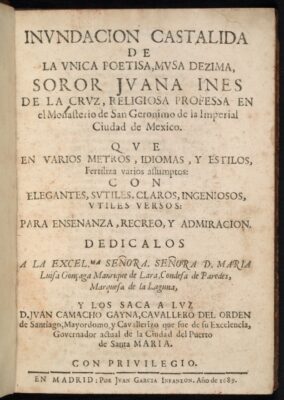
Divino Narciso con su Loa / Divine Narcissus and its Loa
The Divine Narcissus is an auto sacramental, a type of dramatic religious piece originating in Spain which was generally composed for religious festivals. The pieces were usually allegorical in nature, featuring characters standing for human virtues or emotions. This piece has been less analyzed by Sor Juana scholars than others, although it has salient connections to Sor Juana’s feminism, her theological views, and her views on ideal love (Kennet 2000; Grossi 2007). Its Loa, or prologue, consists of a separate play, in this case an allegory of the conquest of the native peoples of Mexico. This particular Loa is important for Sor Juana scholarship because it evidences her engagement with pre-Columbian indigenous ideas, music, and traditions. She intentionally explored these customs as well as her own heritage to forge an identity that was not solely comprised of a cultural European genealogy but also embraced the Americas. Moreover, the duet of plays was written so as to be presented in Madrid, lending credibility to the idea that Sor Juana desired that Indigenous peoples be accorded better treatment by the ruling powers (albeit still by promoting conversion to Catholicism).
Summary of the Loa, or Prologue to Divine Narcissus
In the prologue play, two characters representing the masculine Occident and feminine America celebrate their “God of Seeds” alongside the ebullient character of Music. Two Spanish characters enter. The feminine character of Religion pleads with the masculine and bellicose Zeal for a non-violent conversion rather than a violent conquest. Occident and America then engage in dialogue with Religion and Zeal about their religious beliefs and discover common ground between them: their practice of ingesting their respective Gods parallels that of the washing (or, purifying) themselves prior to worship. Syncretism (the amalgamation of different religions) results when Occident declares that he and America had already known the real “God of Seeds” but wishes to understand him better, which is where Divine Narcissus begins.
Main Issues in Loa
The most striking feature of this prologue play is that Sor Juana seems to empathize with and even identify with Occident and America who, while converted in the end, are not infantilized, dehumanized, demonized, nor treated as irrational. She sympathizes with and rationalizes their belief systems, such as their worship by means of human sacrifice, and goes so far as to connect the Nahua “God of Seeds” with the Catholic supreme being. Although she still qualifies these beliefs as relatively idolatrous—remaining centered on material objects and not strictly veridical, as an adoption of Christian ideology would normally otherwise show—the syncretic proposal is radical and recalls other syncretisms, such as the identification of the Virgin of Guadalupe and the goddess Tonantzín. She also apologizes, in the voice of America, to the “Intelligences” of her audience on behalf of “my own” for the clumsiness of the play to follow. This suggests her self-identification of her own heritage in contrast to that which she explores, and thus grounds an identity that would prove revolutionary over a century later. Alongside two of her short poems composed in Náhuatl—a scrutiny of the Loa and its accompanying music—would have recreated a celebratory Nahua tocotín (a sung text in the Nahua tradition), and may tell us more about the extent of Sor Juana’s interest in Nahua practices and beliefs.
Summary of Divine Narcissus
In this play, the main characters are the Divine Narcissus, an allegory for Jesus Christ; Echo, an allegory for Satan as a fallen angel; Human Nature, a woman who eventually becomes cleansed through piety, diligence, and divine favor; and Grace, an allegory for the Virgin Mary. The entire play is a metaphor for the Eucharist, in which Human Nature searches agonizingly throughout the world for her beloved Narcissus while Echo desires him selfishly and jealously, and in which Narcissus, the source of all beauty and goodness, dies for the sake of mankind. With the assistance of Grace, Human Nature ultimately earns access to a fountain of purity which cleanses her of sin and provides access to God. Alongside other abundant symbols, the image of the flower that results from the death of Narcissus symbolizes the Host, God’s continued presence in the world after Christ’s death, as well as the Mexican native lily.
Main Issues in Divine Narcissus
Interpreting this play turns out to be contentious, both because of the allegorical nature of the characters, the Baroque stylings of the play, and the sometimes polysemic use of the various allegories. For example, Narcissus historically is perceived as a negative character, while Jesus Christ is not, and yet we see them blended by Sor Juana. At the same time, the character of Echo and her companions Arrogance and Self-Love are condemned, even while Echo’s spurning by Narcissus (who can only love himself) seems agonizing to Echo and a source of great torment for her. This could well be a tool with which to speak the otherwise unspeakable, such as a pessimism about Christian doctrine, or it could be a way to subvert expectations in other ways that are meant to bring forth new interpretations of Christian dogma and deepen theological analysis without straying into heresy, such as endorsement of syncretism or universalism. Less likely, it may even be a clumsy recycling of old patriarchal tropes.
One major question is the degree to which this play is a feminist work. According to Stephanie Merrim (1990, 95), Sor Juana’s play “enacts the drama of the divided woman, the dark versus the light heroine,” in the characters of Human Nature, who is selfless and self-debasing and achieves purification, and of Echo, who is selfish and jealous and receives eternal torment for her arrogance. However, other authors suggest an interpretation wherein the intent is to lionize the divine feminine through the character of Grace/Mary and the purifying stream, and possibly to generate a multi-gendered conception of Christian divinity altogether, suggesting love between complementary opposites as the source of hypostatic union, or the combination of divine and human natures in the single person of Christ. (Kennet 2000). The play also portrays Human Nature as feminine yet active in her searching for salvation and the object of her love, by using her senses in admiring divine Creation, reading both the divine and profane arts, and engaging in spiritual devotion.
The play was composed to celebrate the Eucharist. As such, the other major issues are theological, having to do with the true nature and meaning of Christ’s sacrifice, the means for its accomplishment, and the means for human beings to reattain divine favor. It is not knowledge, disobedience, or an attachment to the profane in this play that keeps Echo or Human Nature from divine purification, but instead greed, self-aggrandizement, and un-virtuous love. Effort is also not sufficient for the attainment of divine Grace, for both Echo and Human Nature strive for Narcissus’ affections: instead, one needs the fortuitous intercession of God’s and Mary’s mercy and Christ’s self-sacrifice, which will provide one not with divine love, but with the opportunity for union with the divine through purification and the return to one’s unblemished essential nature. The imagery is empowering but also sobering, equalizing mankind as a whole and inviting a universalist reading of values common to distinct religious traditions, while also commanding exemplary virtue and devoted worship without the expectation of blessings or favors. The attentive spectator is invited to read perhaps deeper meanings in the juxtapositions between the characters and their motivations.
4.9 Devotional Exercises
Summary
The Devotional Exercises are a series of short meditative and prescriptive texts written for people to prepare for the Feast of the Incarnation during Christmas. There are nine Devotional Exercises in total, all of which must be performed successively in the nine days that precede the Feast. The Devotional Exercises reflect a tripartite structure: each begins with a meditation about one aspect of the mystery of the Incarnation (in particular, a focus on aspects that pertain to the nature of the Virgin Mary), contains an offering consisting of a series of petitions addressed to the Virgin to intercede with God with respect to several issues, and ends with a series of specific prayers, fasts, good deeds, and contrition for past sins.
Main Issues
Despite their brevity, the Devotional Exercises present some interesting religious and practical ethics that are made clear by Sor Juana herself at the onset. She’s worried that, despite the central role that the Virgin Mary plays in the salvation of human beings, we might succumb to “the dumbing forgetfulness” (el torpe olvido) of the many blessings and advantages that we owe to her. To remedy this, she engages in each devotional exercise through a meditation on one aspect of the nature of the Virgin Mary that highlights her protective and nurturing role with respect to human beings while also presenting the virtues she possesses which make her a model of Christian excellence. The two central claims that emerge from the meditations are as follows: (1) the Virgin has been able to play a protective and nurturing role with respect to human beings in virtue of having certain virtues; and, (2) among all the virtues of the Virgin Mary, some (such as humility, patience and charity) have a crucial role. For Sor Juana, it is through the practice of these specific virtues that human beings are able to transcend their self-serving impulses, their arrogant tendencies, and their wrathful inclinations. In virtue of this, Sor Juana often prescribes the performance of certain actions that will help us combat our vicious habits. For instance, to combat envy, she prescribes practicing charity, as the Virgin Mary did, by visiting sick people to keep them company or to perform some service for them. In order to combat our tendency to wrath, Sor Juana advises her readers to practice patience (just as Mary did) by learning to endure the presence of things or people that anger or disgust us.
5. Correspondence Guide
Correspondence within intellectual circles was an immensely important means of communication throughout the early modern period and Sor Juana especially depended upon such methods of socialization due to her cloistered lifestyle. Intellectual women of the era were also often especially reliant on letter writing as they were normally excluded from institutions of learning and discouraged from publishing their intellectual views. Central to the correspondence of Sor Juana was her famous epistolary debate that caught the attention of the Spanish Inquisition and was later famed in multiple continents, resulting in her initial persecution and posthumous renown. Her correspondence is of special interest because it offers insight into her intellectual beliefs. In this section we outline her known correspondence with special emphasis on the role that correspondence played in shaping our modern understanding of the cloistered nun.
A letter addressed to Father Antonio Nuñez, Sor Juana’s Jesuit confessor, was discovered by Monsignor Aureliano Tapia Méndez in 1980. Although it was written in two different hands, the letter reflects Sor Juana’s distinct writing style. It was reportedly composed around 1681, a decade before the publication of her famous Reply to Sor Filotea. In this “Letter from Mother Juana Inés de la Cruz Written to the Most Reverend Father Antonio Nuñez of the Society of Jesus,” she demonstrates her defiance of patriarchal and ecclesiastical authority even more explicitly than in her later correspondence. Its structure is so similar to the Reply to Sor Filotea that some modern reports have considered it to be an early draft of her ideas. Sor Juana presents Nuñez as intolerant, persecutory, envious, and cloaked with pious zeal. The blatantly rebellious tone was inconceivable for a nun to express at the time, and demonstrates tensions between the two figures.
The Reply to Sor Filotea—the semi-public correspondence that was first published by the Bishop of Puebla, Manuel Fernández de Santa Cruz, without Sor Juana’s consent—is undoubtedly her most well-known and criticized epistolary work. Other surviving correspondences like the Letter Worthy of Athena made clear her critical and erudite mind, expressed during heightened religious sensitivity brought about by the Spanish Inquisition. The letter irrevocably changed her life and led to further restrictions on her freedom in the convent. Additionally, her superiors demanded that she give up her intellectual activities and lead a more pious life.
A critique of the Letter Worthy of Athena was published in 1690 by a fictional “Sor Filotea,” who chastised Sor Juana’s excessive interest in worldly issues, as opposed to the pure, religious devotion expected of a Hieronymite nun. The person behind this penname is thought to be the Bishop of Puebla, to whom the original letter was addressed. It is undeniable that the publication of this critique had a negative effect on Sor Juana’s standing with contemporaneous Catholic authorities. The Bishop’s intentions are still debated, sparking several different theories. One idea is that he took on the name to allow Sor Juana to respond in a more liberal manner than she would have otherwise been able to do because of his position in the Church as her superior. Prior to this debate, Sor Juana and the Bishop were quite close and might have continued their relationship after the initial publication of Letter Worthy of Athena. However, the Bishop’s political intent and intended target remain unclear. What is evident is that the inflammatory document caused Sor Juana to fall from favor with ecclesiastic authorities.
Perhaps more interesting and widely discussed is the debate’s namesake: the Reply to Sor Filotea written in 1691. While the content of the letter is fascinating due to its exposure of Sor Juana’s internal battle between her adherence to and discontent with Catholic customs, it was never actually sent to anyone in particular, it was published only posthumously.
A newly discovered document has brought to light more of Sor Juana’s religious and proto-feminist views: the Carta de Serafina de Cristo. The discovery was made in 1996 by Elias Trabulse, a Mexican chemist and historian who was motivated by the renewed interest in Sor Juana following the publication of Octavio Paz’s The Traps of Faith (1982). He investigated the origins of this document and identified Sor Juana’s writing, determining that it was written after Letter Worthy of Athena but before the Reply. The primary source lay dormant for centuries because it was written under the pseudonym “Serafina.” Trabulse argues in his examination that it was addressed to the Bishop of Puebla. Interestingly, he notes that Serafina previously composed a letter addressed to the Castilian priest Antonio Nuñez and not to the more traditional recipient, a Portuguese Jesuit priest like António Vieyra. Trabulse thus deduces that the Letter Worthy of Athena was indeed directed towards Antonio Nuñez.
Antonio Alatorre and Martha Lilia Tenorio, in their book Serafina y Sor Juana (2013), refute Trabulse’s analysis of the letter. Their main concern is with the document’s authenticity as a manuscript penned by Sor Juana under the pen name Serafina. Prior to this, Sara Poot-Herrera, in her Los guardaditos de Sor Juana (1999) notes that the Carta de Serafina might not be in the hand of Sor Juana, but it was inspired by her intellectual ideas and produced from within her convent. The debate over the letter’s authenticity continues and extends the active discourse in Sor Juana scholarship.
No discussion of Sor Juana’s correspondence would be complete without mentioning her close friendship to María Luisa Manrique de Lara y Gonzaga, the Vicereine of New Spain (1680–1686). Historians Hortensia Calvo and Beatriz Colombi published their Cartas de Lysi (2015), a collection of the private letters between Sor Juana and María Luisa that are currently held in Tulane University’s archives in New Orleans. The book is a critical edition of the newly discovered correspondence, revealing the influence that Sor Juana had in the life of the court, even after she left for her Order.
It is also known that Sor Juana corresponded with Diego Calleja, but these letters have not yet been located. Calleja was the author of her posthumous biography, published in 1700. He was a Jesuit who has largely been remembered for what he wrote about other contemporary figures, including Queen Mariana of Austria and, especially, Sor Juana. The letters between Sor Juana and Calleja not only reveal a new side of Sor Juana, but shed more light on Calleja as well.
It is said that Sor Juana abandoned her time-intensive letter writing at the end of her life, retreating to a devout life of service in the convent. However, Trabulse shows in his edition of the Carta de Serafina de Cristo that an inventory of goods left by Sor Juana at her death is mentioned in the letter, including “fifteen files of writings, mystical and worldly verses,” which she bequeathed to her family. Unfortunately, they have not been found. This inventory could suggest that she had not undergone a conversion that caused her to stop intellectual efforts and keep silent until her eventual death, as was insisted by the Church at the time, but instead continued her philosophical explorations. Perhaps there are more letters to be discovered among these writings from the last years of her life. What might they say about this nun, who faced so much religious persecution and yet insisted on maintaining both her faith and her analytical perspective?
6. Connections
| Name | Description of Connection |
| Antonio Nuñez de Miranda (1618–1695) |
Nuñez was Sor Juana’s confessor, and was strongly opposed to the intellectual efforts of women, preferring that women express a simple devotion to Christ. Due to their drastic differences in opinion, the Sor Juana and Nuñez had a tumultuous relationship. Matters worsened as she began to gain favor and fame in the court of Tomás de la Cerda y Aragón, and Nuñez began to grow jealous and fear his own declining status. She felt emboldened by her close relationship to the Viceroyals, and wrote a complaint about him in 1681, in which she took on a drastically authoritative and critical tone. This critique eventually led her to fire him as her personal confessor. |
| Antonio Sebastián Álvarez de Toledo (1622–1715) |
Álvarez de Toledo was the 2nd Marquess of Mancera, and therefore the representative of the Crown in New Spain. The Viceroyal was seen as the “living image” of the Spanish monarchy, and his court was a center of wealth and learning in the New World. Sor Juana entered his court in 1664 in a patron and client relationship due to her many talents and ability to entertain the court. |
| Lady Leonor de Carreto (ca. 1651–1695) |
Lady Leonor was the Vicereine of New Spain—the wife of the 2nd Marquess of Mancera. Sor Juana gained a place in her court as a lady-in-waiting with her ability to entertain through wit, poetry, and works of theatre. The privilege of such a close relationship with the Viceroyals surely helped her gain immense connections in the intellectual life of the New World. |
| Tomás de la Cerda y Aragón, Marquess of Laguna (1638–1692) |
The Marquess of Laguna was the new Viceroy of New Spain from 1680–1686, after the 2nd Marquess of Mancera and Lady Leonor de Carreto. He is better known as Conde de Paredes, though he only held this title as consort. Sor Juana’s most famous connection to him was her monumental work, Allegorical Neptune, which was written to commemorate a triumphal arch made in celebration of the Viceroy. The work was very well received, and cemented her relationship with the Viceroyals, who became her patrons, and even friends. |
| María Luisa Gonzaga Manrique de Lara (1649–1721) |
As the wife of Tomás de la Cerda y Aragón, titled Condesa de Paredes, she held much the same position in court as the previous Vicereine, Lady Leonor de Carreto. She was a patron of Sor Juana during the height of her productivity and fame, and it seems that their relationship was very close. She appears in Sor Juana’s sonnets as “Laura.” Later, in 1689, when the Condesa was back in Spain, she helped Sor Juana publish her work. |
| António Vieyra (1608–1697) |
Vieyra was a renowned Portuguese Jesuit priest, and the author of an old sermon that Sor Juana so famously engaged with and criticized in her Letter Worthy of Athena. She took issue with his understanding of Christ’s demonstrations of love, siding instead with St. Augustine. In addition to being a priest, he was also a diplomat, philosopher, orator, writer, and member of the Royal Council to the King of Portugal. As he was such a respected individual, it was highly inflammatory for Sor Juana to criticize the logic in his sermon, although her approach to the critique is understandable when one considers that it was never meant to be published. |
| Manuel Fernández de Santa Cruz (1637–1699) |
Also known by his title, the Bishop of Puebla, Manuel Fernández was central in Sor Juana’s intellectual life, as he was the publisher of the Critique of a Sermon under a new name, Letter Worthy of Athena, and attached his own critique of her opinion under the pseudonym of “Sor Filotea.” The relationship between the two individuals is disputed, as scholars still cannot directly say what the Bishop’s intentions in publishing this private letter could have been. |
| Diego Calleja (ca. 1638–1725) |
Calleja was Sor Juana’s first biographer, publishing her life in 1700, five years after her death. Not much is known about his life, other than his interest in the intellectual life of his era, and his biographical works, which also included one on Queen Mariana of Austria. It is known that Sor Juana and Calleja had a correspondence, although these letters have unfortunately not been located. |
| Juan Vélez de Guevara (1611–1675) |
Vélez de Guevara collaborated with Sor Juana on the second of her secular comedies, “Love is a Labyrinth,” for which he wrote the second act. It is clear that he was an accomplished playwright who represented the ideals of the Spanish Baroque. His father, Luis Vélez de Guevara, was a Spanish dramatist and novelist. In his time, he was well-known as a writer of short theatrical pieces, most notably entremeses and bailes, which were performed at the Spanish court. He also collaborated with several Spanish playwrights. Consequently, he was an important contact for Sor Juana, due to his connections in continental Europe, and among the intellectuals of the Spanish Golden Age in particular. |
| Don Francisco de Aguiar y Seijas (1632–1698) |
Seijas was one of the two religious men who forced Sor Juana to publicly renounce her intellectual career and renew her vows as a “bride of Christ”—the other being Father Antonio Nuñez de Miranda. He was her Archbishop and therefore a superior in the Catholic Church. Their relationship quickly deteriorated after the Letter Worthy of Athena was published. He consequently put her on trial for heresy, insubordination, and activities not compatible with the religious state. Upon his death at age 65, a campaign immediately began in Mexico for his beatification, although these efforts were unsuccessful. |
| Juan Ignacio de Castorena (1668–1733) |
Castorena was the Bishop of Yucatán and a member of a wealthy, noble family. He received a Jesuit education in Mexico City and a doctorate of law before moving to Madrid where he received a doctorate of theology. He edited Sor Juana’s works and helped her publish in Spain with his connections on the continent. His interest in publishing ran deeper, however, as he later went on to found the first Mexican newspaper on January 1, 1720, after Sor Juana’s death. |
| Isabel Ramírez Santillana (1626–1690) |
Sor Juana was the illegitimate child of Isabel Ramírez, a criolla woman. Not much is known about Isabel, other than that Sor Juana begged her mother to send her to school dressed as a boy so that she could be permitted to learn. Isabel never gave in to this request, though she did send her daughter to Mexico City in 1656 to live with her sister (Sor Juana’s maternal aunt) and her brother-in-law, María Ramírez Santillana and Juan de Mata, presumably to give the girl more opportunities in the big city. |
| Pedro Manuel de Asbaje y Vargas Machuca | Asbaje y Vargas Machuca was Sor Juana’s father, though she did not know much about him because he left very early on in her life. He was a Spanish captain. |
| Don Pedro Ramírez de Santillana | Don Pedro was Sor Juana’s maternal grandfather and influenced her early intellectual development. His extensive library captivated her as a three-year-old child, at which time she began her pursuit of knowledge and her lifelong autodidacticism. |
| Martín de Olivas | Sor Juana began her study of Latin in 1659, under the tutelage of Martín de Olivas in Mexico City. It is said that she picked up the language in only 20 lessons with him. Her respect for her tutor is evident from a sonnet that she wrote for him (Soneto a Martín de Olivas), in which she praises his intellect and says that she wishes to imitate him. |
| Carlos de Sigüenza y Góngora (1645–1700) |
Don Carlos was one of the first great intellectuals born in the New World. He was a polymath and writer who held many important colonial government and academic positions during his life. As it is said that 17th-century Mexico City had two savants—Sor Juana and Don Carlos—his friendship with the nun is a well-known part of Mexican intellectual history. They lived quite close to each other, which made it easy for them to meet in the locutorio of the convent, where they engaged in both religious and secular intellectual discussions called tertulias. As a close friend, he encouraged her pursuit of science—a lesser-known side of the nun. After she died, he delivered her eulogy at the funeral. While this address is lost to history, we can get an idea for what he would have said by considering his remarks about her in 1680: “There is no pen that can rise to the eminence that hers o’ertops…[the fame of] Sor Juana Inés de la Cruz will only end with the world” (Leonard 1959, 191–92). |
7. Online Resources
Biblioteca Virtual Miguel de Cervantes: http://www.cervantesvirtual.com/portales/sor_juana_ines_de_la_cruz/
Contains a large bibliography of works by Sor Juana and by commentators, as well as audio files, images, and open-access articles.

